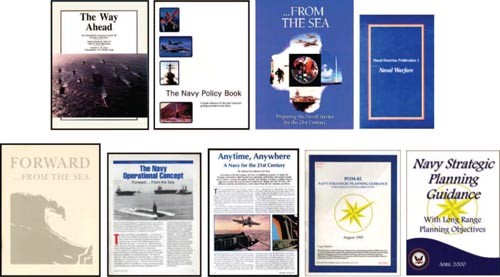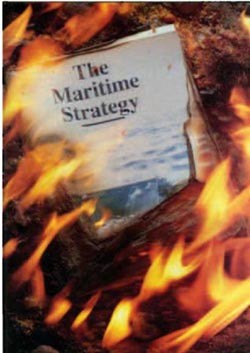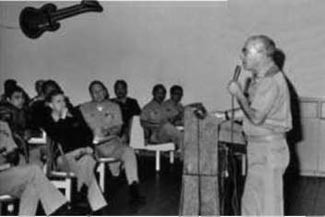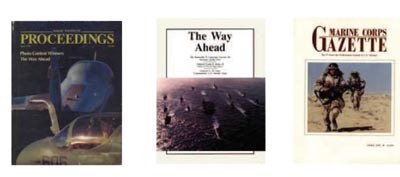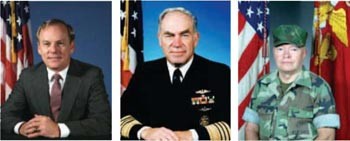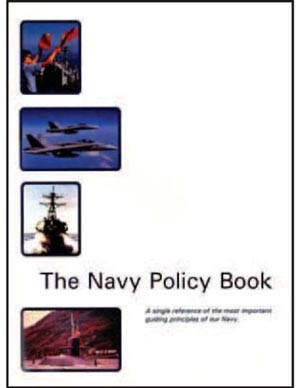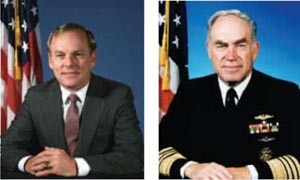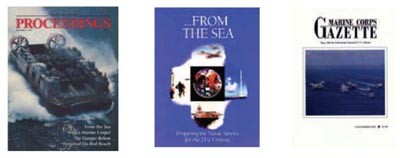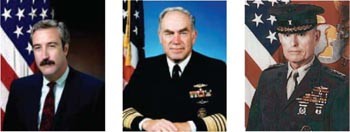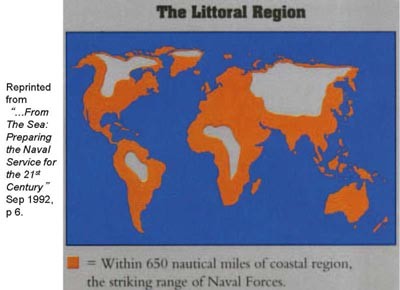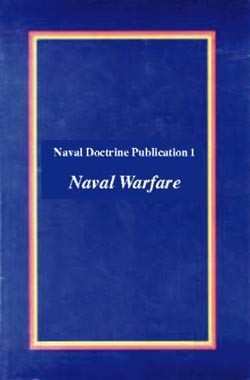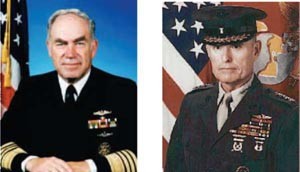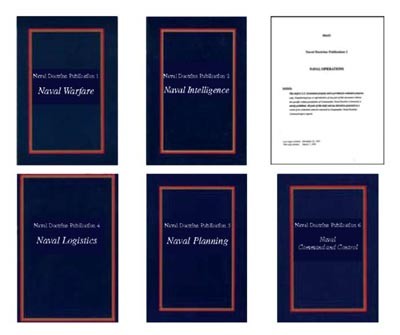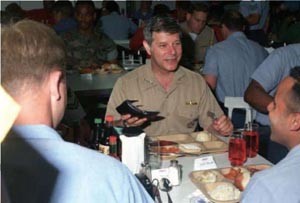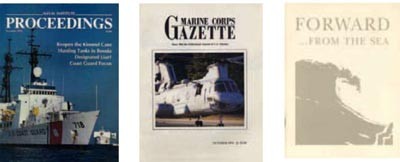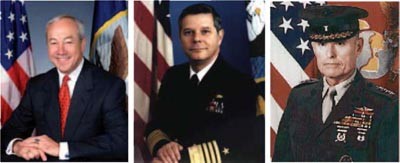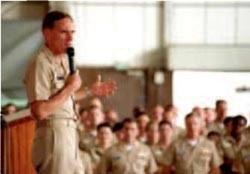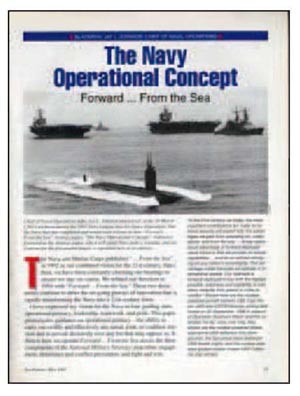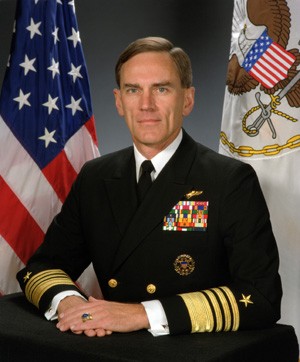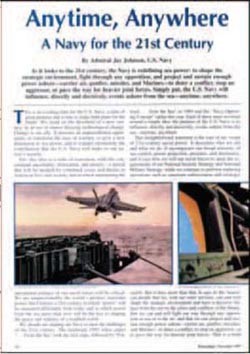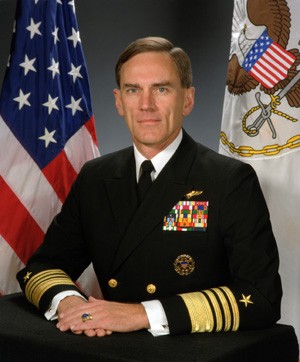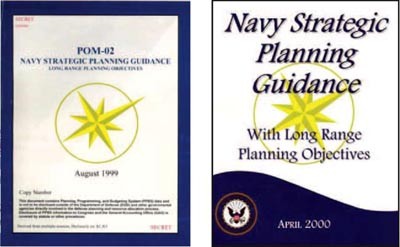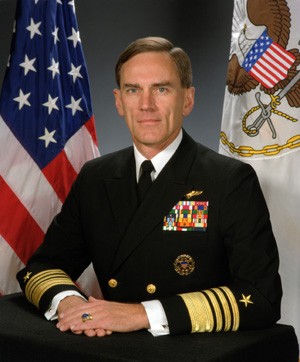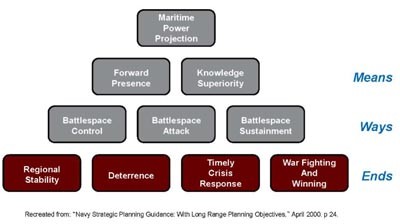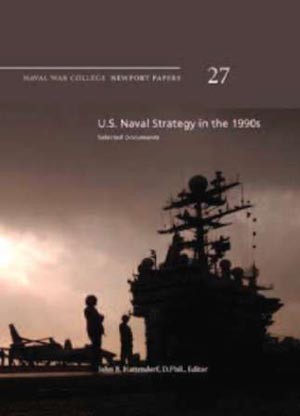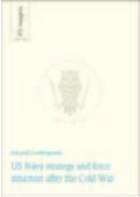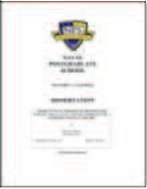
The Navy Department Library
US Navy Capstone Strategies and Concepts (1991-2000)
Strategy, Policy, Concept, and Vision Documents
Peter M. Swartz with Karin Duggan
MISC D0026416.A2/Final
March 2012
CNA
ANALYSIS & SOLUTIONS
CNA is a not-for-profit organization whose professional staff of over 700 provides in-depth analysis and results-oriented solutions to help government leaders choose the best courses of action. Founded in 1942, CNA operates the Institute for Public Research and the Center for Naval Analyses, the federally funded research and development center (FFRDC) of the U.S. Navy and Marine Corps.
CNA Strategic Studies (CSS), created in 2000, conducts high-quality research on and analysis of issues of strategic, regional, and policy importance. CSS' analyses are based on objective, rigorous examination and do not simply echo conventional wisdom. CSS provides analytic support to U.S. Government organizations and the governments of partner countries. CSS also maintains notable foundation-sponsored and self-initiated research programs. CSS includes a Strategic Initiatives Group, an International Affairs Group, and a Center for Stability and Development.
The Strategic Initiatives Group (SIG) looks at issues of U.S. national security, and military strategy, policy and operations, with a particular focus on maritime and naval aspects. SIG employs experts in historical analyses, futures planning, and long-term trend analysis based on scenario planning, to help key decision makers plan for the future. SIG specialties also include issues related to regional and global proliferation, deterrence theory, threat mitigation, and strategic planning for combating threats from weapons of mass destruction.
The Strategic Studies Division is led by Vice President and Director Dr. Eric V. Thompson, who is available at 703-824-2243 and on e-mail at thompsoe@cna.org. The executive assistant to the Vice President and Director is Ms. Rebecca Martin, at 703-824-2604.
The principal author of this study thanks especially Karin Duggan for graphic assistance; Loretta Ebner for administrative assistance; Gregory Kaminski, Laurie Ann Lakatosh, and Rhea Stone for library assistance; and Dana Smith and Anwar Fry for production assistance. A full listing of substantive contributors can be found in Peter M. Swartz and Karin Duggan, U.S. Navy Capstone Strategies and Concepts: Introduction and Background: Volume I, (D0026421.A1, December 2011). A full listing of all volumes in the CNA Navy Strategy series can be found on the inside back cover of this document.
Approved for distribution: March 2012
This document represents the best opinion of the author at the time of issue. It does not necessarily represent the opinion of the Department of the Navy.
Approved for public release. Distribution unlimited.
Copies of this document can be obtained through the Defense Technical Information Center at www.dtic.mil or contact CNA Document Control and Distribution Section at 703-824-2123.
Copyright 2012 CNA
This work was created in the performance of Federal Government Contract Number N00014-11-D-0323. Any copyright in this work is subject to the Government's Unlimited Rights license as defined in DFARS 252.227-7013 and/or DFARS 252.227-7014. The reproduction of this work for commercial purposes is strictly prohibited. Nongovernmental users may copy and distribute this document in any medium, either commercially or noncommercially, provided that this copyright notice is reproduced in all copies. Nongovernmental users may not use technical measures to obstruct or control the reading or further copying of the copies they make or distribute. Nongovernmental users may not accept compensation of any manner in exchange for copies. All other rights reserved.
Dr. W. Eugene Cobble, Jr.
Director, Strategic Initiatives Group
Contents
| CNO Admiral Frank Kelso The Way Ahead The Navy Policy Book ...From the Sea Naval Doctrine Pub 1: Naval Warfare |
2 3 21 30 56 |
| CNO Admiral Jeremy M. Boorda Forward...From the Sea |
75 76 |
| CNO Admiral Jay Johnson Navy Operational Concept Anytime, Anywhere Navy Strategic Planning Guidance |
98 99 118 133 |
| Companion references on USN 1990s documents | 150 |
1990s: End of the Cold War
Reprinted from Proceedings with permission; Copyright (c) 1990 U.S. Naval Institute www.navalinstitute.org. April 1990. Vol 116/4 p 33., "Correcting Three Strategic Mistakes," written by LT Niel L. Golightly, USN.
--1--
ADM Frank B. Kelso III (CNO Jun 1990-Apr 1994)
| Apr 1991 | The Way Ahead Vision |
| May 1992 | The Navy Policy Book Policy |
| Nov 1992 | ... From the Sea Vision |
| Mar 1994 | Naval Warfare (NDP 1) Doctrine |
Submarine officer
3rd submarine officer CNO in a row
Served under Presidents Bush, Clinton; SECDEFs Cheney, Aspin, Perry; SECNAVs Garrett, O'Keefe, Dalton
SECNAV John Lehman protege
As Commander, Sixth Fleet, combat veteran of Libya crises (1986)
CNO term clouded by criticism of handling of "Tailhook" incident (1991)
Strained relations with USMC
Signature programs: Total Quality Leadership (TQL): Finding USN process efficiencies; Virginia-class SSN
--2--
Had participated in development and testing of The Maritime Strategy throughout his career as a flag officer
Said that times had changed; the Maritime Strategy now "on the shelf" in case needed later (1990)
Called for a new "maritime policy", vice strategy
Strove to supplement it with new visions, policies doctrines, processes, both internal & external
Fostered contributions to Navy thinking by other flag officers, e.g.: Art Cebrowski, Paul David Miller, Bill Owens
A reference: Admiral William Owens, High Seas (1995)
The Way Ahead (1991)
--3--
Overview
Signed by SECNAV Garrett, CNO ADM Kelso, CMC Gen Gray (Apr 1991)
Billed as a "Way Ahead"
Primary targets: USN, USMC officer corps
Short (12 pp) UNCLAS US Naval Institute Proceedings & Marine Corps Gazette articles; & stand-alone pub
Drafted in OPNAV Naval Warfare directorate (OP-07)
Threats seen as regional
Re-emergent global threat unlikely but possible
Called for new deployment patterns, forward presence, surge, emphasis on presence & MOOTW
Remarkably prescient
Little influence at the time
Signed by:
SECNAV H. Lawrence Garrett, III
CNO ADM Frank B. Kelso, II
Almost 1 year in office
CMC Gen Alfred M. Gray, Jr.
--4--
What it was
Billed as a "Way ahead"; "an article"
Actually a "vision"
Short UNCLAS US Naval Institute Proceedings, Marine Corps Gazette articles (Apr 1991)
Stand-alone reprint pub
12 pages
Not repeated verbatim in Posture Statements
Why it was written (I)
To demonstrate that the Navy understood the world had changed and that the Navy was changing too
To maintain and re-forge USN internal consensus on USN rationale
To provide a vision with a detailed agenda for the changes the Navy foresaw it would have to make
To provide a replacement for the suddenly-obsolete Maritime Strategy; replacing SLOC defense w/"enabling"
--5--
Why it was written (II)
To show links between the Navy & evolving Bush administration policies, refocusing on regional threats
To provide a basis for new rationales for new, lower 451-ship "Base Force" USN force level goal
To demonstrate Navy-Marine Corps solidarity
To answer USAF "Global Reach - Global Power" (1990)
Primary targets: USN, USMC officer corps
Context (I)
2nd year of Bush administration (1989-93)
SECDEF Cheney (1989-93)
CJCS GEN Colin Powell (1989-1993)
A dominant force in US defense strategy & policy making
New CNO ADM Kelso (1990-94)
US economy pulling out of recession; unemployment & inflation rates climbing; high U.S. gov't deficit spending
Low & declining oil prices
Fundamental change in world power relationships
Cold War ending
Soviet Union still intact; military & naval power stagnating
Warsaw Pact disintegrating but still extant
Germany reunited (Oct 1990)
NATO expansion along south Baltic littoral (former DDR) began
US-Soviet maritime boundary re-confirmed (1990)
--6--
Context (II)
Bush administration calls for a "new world order" (Sep 1990 speech)
Operations DESERT SHIELD & DESERT STORM ongoing (Aug 1990-Feb 1991)
Operation SEA SOLDIER IV (Jan 1991)
Oman amphibious exercise/deception operation
Largest amphibious landing since STEEL PIKE (1964)
Increased role of CJCS GEN Colin Powell & Joint Staff
Press discussion of a so-called "Powell Doctrine"
Should US go to war, it should apply overwhelming force
Context (II)
Bush administration calls for a "new world order" (Sep 1990 speech)
Operations DESERT SHIELD & DESERT STORM ongoing (Aug 1990-Feb 1991)
Operation SEA SOLDIER IV (Jan 1991)
Oman amphibious exercise/deception operation
Largest amphibious landing since STEEL PIKE (1964)
Increased role of CJCS & Joint Staff
US estrangement from PRC since Tiananmen Square crackdown (Jun 1989)
Leadership visits, ship visits, arms sales cancelled * Democracy comes to Taiwan (from 1987)
Trade disputes threaten US relations with Japan
Japanese economic crisis (1990-91)
--7--
Context (III)
USS Iowa turret explosion & investigation (1989)
USN "Base Force" 451-ship Battle Force force goal (1991)
Declining USN force levels & DON budgets
USN in 1991: 526 battle force ships; 11 new ships authorized
Down 42 ships from 1987; down 21 ships from 1990
Decommissioning of all 46 Knox-class ASW FFs began (1991)
SECDEF cancelled A-12 (1991)
Annual ADM Charles M. Cooke Conferences for Naval Strategists & Planners began (1990)
Coordinators: NPGS (CDR Brown) & NWC (Dr. Daniel)
Unofficial DC-area "Navy Discussion Group" (1989-91)
Convener: CAPT Jim Stark
Participants included The Way Ahead contributors
Context (IV)
US Navy immediate post-Cold War expectations (on eve of Operation Desert Shield & promulgation of CJCS GEN Powell "Base Force" construct):
US Navy Cold War strategy, concepts, doctrine, tactics & systems very adaptable to post-Cold War environment & conflicts
US Navy more relevant to post-Cold War environment & conflicts than other services
US Navy stature & budget share will go up
US Navy confident in its ability to control its own destiny
Eroding of the internal USN consensus of the 1980s on USN rationale
--8--
Cited references
Title 10 of U.S. Code
President Bush Aspen speech (Aug 1990)
Soviet threat remote, but could recur
US forces needed for peacetime forward presence, rapid regional crisis response
Need to restructure US forces as well as reduce by 25%
FMFM 1 Warfighting (1989)
Also cited: The Maritime Strategy
Context: Other important contemporary publications (I)
Goldwater-Nichols Act (1986)
1st Bush National Security Strategy (1990)
CJCS GEN Powell "Base Force" (1991)
451 -ship Battle Force goal
CJCS Joint Military Net Assessment (JMNA) (Mar 1991)
1st CJCS Global Naval Force Presence Policy (GNFPP) (1991)
Defense Planning Guidance (DPG)
Contingency Planning Guidance (CPG)
--9--
Context: Other contemporary publications (II)
CNO Strategic Study Group (SSG) reports
USMC, Small Wars Manual (reprint of 1940 ed.) (1987)
USN "Worthington Study" on riverine warfare (Dec 1990) (ignored)
CNA studies on USN presence & responses to crises
"DON LIFT 2" study (1990)
FMFM 1-1 Campaigning (1990)
Col John Warden, The Air Campaign (1988)
SECAF Rice "Global Reach-Global Power" (1990)
OPNAVINST 3000.13A, Personnel Tempo of Operations (Dec 1990)
Context: Other contemporary publications (III)
William S. Lind et al., "The Changing Face of War: Into the Fourth Generation." Marine Corps Gazette & Military Review (Oct 1989)
Francis Fukuyama, "The End of History," National Interest (1989)
Global triumph of Western liberal democracy
Samuel Huntington, "The Clash of Civilizations?" Foreign Affairs (1989)
Carl Builder, The Masks of War (1989)
CAPT Charles Koburger USCGR (Ret), Narrow Seas, Small Navies, and Fat Merchantmen: Naval Strategies for the 1990s (1990)
--10--
How it was written (I)
Various aborted OPNAV staff efforts begun, responding to changes in the world (1989-1990)
Key players: CAPT Dick Diamond (OP-607, later OP-603); CAPT Jim Stark (OP-OOK); HQMC PP&O
Discussion venues:
Navy Long-Range Planners' Conference at USNA (1989)
Unofficial "Ancient Mariners" officer study group
Kicked around emerging naval concepts
CAPT Jim Stark (OP-OOK) administered
Representation from across OPNAV
CDR Joe Sestak & "enabling" concept
How it was written (II)
Personalities:
New CNO ADM Frank Kelso (Jun 1990)/new EA CAPT Dan Murphy
VADM Paul David Miller (OP-07)
Former close Lehman Secretariat Kelso, Murphy colleague
CAPT Bill Center, CDR Rick Wright (principal OP-07 drafters)
(VADM Barney Kelly) (New OP-06)
CAPT Dick Diamond (OP-607, then OP-603)
CDR Mike Dunaway (principal OP-603 drafter)
CMC Gen Gray
HQMC PP&O LtGen Carl Mundy; AO Maj Al Heim
--11--
How it was written (III)
OPNAV Strategy Branch (OP-603) developing a new strategic concept (since Feb 1990)
Self-initiated by CAPT Dick Diamond (Branch head)
Unsupported by OP-06 (VADM Kelly)
SECNAV/CNO "The Way Ahead" memo tasked OPNAV Director for Naval Warfare (OP-07) to develop formal USN program planning options for discussion and decision. USMC to participate (23 Aug 1990)
3-way rivalry developed: OP-06, OP-07, & HQMC PP&O
Competing OP-06 & OP-07 briefings all through 1990
USMC insistence on full equality, heavy emphasis on amphibious, expeditionary warfare
How it was written (IV)
OP-603 "Won if by Sea" briefing circulated, briefed to CMC Gen Al Gray (Sep 1990)
OP- 07 drafted Final "Way Ahead" version
Adopted earlier OP-603-incubated "Won if by Sea" ideas
CNO ADM Kelso-CMC Gen Mundy-OP-07 VADM Miller endgame at CNO Quarters
Drafting essentially completed before Operation Desert Storm (Feb 2001)
Published as US Naval Institute Proceedings, Marine Corps Gazette articles (Apr 1991)
USN-USMC equality drafting, signing, publishing
--12--
Outline
Implications of change: National security policy
An evolving strategy
Combined and joint operations
Changing employment/deployment concepts
Changing force capabilities and structure
The Navy of the 1990s and beyond
Key ideas (I)
"The Maritime Strategy...remains on the shelf."
Hedge vs. resurgent Soviets
"Meeting our presence requirements with fewer assets calls for...new patterns in length and location of deployments, as well as in the composition of carrier battle groups and amphibious ready groups"
"The changes occurring in our security environment will require us to break out of these hubs"
USN SSNs "freed from a nearly full-time requirement to train for ASW in far forward areas...can now be available for more regional power projection and support missions"
--13--
Key ideas (II)
"The need for focused forward presence & credible surge capability - more than historical deployment patterns - will dictate peacetime employment of naval forces"
Last call for "credible surge capability" until 2003
"We must continue to distribute all forms of striking firepower among many platforms"
"Presence; humanitarian assistance; nation-building; security assistance; and peacekeeping; counter-narcotic, counterterrorist, counterinsurgency, and crisis response operations will receive new emphasis as we focus our efforts on developing and maintaining regional stability"
Key ideas (III)
Change is necessary due to:
Uncertain world; end of bipolarity & central agreed-upon threat
Constrained available resources
Threats seen as regional
Re-emergent global threat unlikely but possible. Focus on "regional contingencies in trouble spots"
Preparation for war with Soviets less important
Cut back on USN ASW forces, e.g.: SSNs, FFs)
Still need to be on guard against possible resurgent Soviet threat
--14--
Key ideas (IV)
Global proliferation of military technology
Joint power-projection ops required
Strategic sealift: "a critical component of our maritime force structure"
Jointness seen as coordination among services, not integration
Key ideas (V)
Zumwalt/Turner terms used as vocabulary, not as a framework
Cited 4 elements of Bush Administration national security policy (from 1990 Aspen speech)
Deterrence
Nuclear & conventional
Forward presence
Crisis response
Power projection & keeping the sea lines of communication open
Force reconstitution
Heavy emphasis on 1st 3 elements, especially power projection; less on reconstitution
--15--
What was new? (I)
Recognition that the world had changed dramatically
Attempt to lead change
Major USMC influence. USN-USMC drafting, signing & publishing equality
Focus on what would later be called shaping
Emphasis on credibility of forward deployed forces
What was new? (II)
Focus on special nature of naval operations in littoral regions
Naval services to "pave the way" for other joint, combined forces
"Enabling and participatory"
Call for "transformation throughout the naval services"
451-ship "base force" goal
Total Quality Leadership (TQL) approach initiated in USN & USMC
--16--
Not addressed
World trade issues and globalization
Threats to the homeland
Piracy threats
U.S. Coast Guard
Allied navies
But allied forces in general were discussed
Sea-based ballistic missile defense
U.S. merchant marine, industrial base, shipbuilding
U.S. government interagency partners
Non-governmental organizations (NGOs)
Naval arms control as an issue Blockade as a discrete naval operation
Mentioned only in passing
Sea control
--17--
Subsequent analyses & critiques (I)
Laura Zabriskie, "New Maritime Strategy will Elevate Marine Corps' Role in Naval Operations," Inside the Navy (Dec 24, 1990)
Dr. Scott C. Truver, "Tomorrow's Fleet," US Naval Institute Proceedings (Jun 1992)
CAPT Bradd C. Hayes, "Keeping the Naval Service Relevant," US Naval Institute Proceedings (Oct 1993)
James Blaker, The Joint Mission Area Assessment Process (CNA) (Feb 1994)
Subsequent analyses & critiques (II)
"The Main Aspects of the 'New U.S. Naval Strategy,' in Meconis & Makeev (eds.), U.S.-Russian Naval Cooperation (1996)
Amund Lundesgaard, U.S. Navy Strategy and Force Structure after the Cold War (Nov 2011)
CAPT Peter Haynes USN, "American Naval Thinking in the Post-Cold War Era: The U.S. Navy and the Emergence of Maritime Strategy, 1989-2007" (Ph.D. dissertation: Naval Postgraduate School, Monterey (Dec 2011))
--18--
Criticisms
Reflected pre-Desert Storm Navy-Marine Corps optimism as to their future greater relevance than Army & Air Force
Did not address lessons of the war; out of date
Not radical enough: Did not reflect need for big changes in Navy policies, strategy, processes, organization
Merely an attempt to save USN force structure
Made no choices. Set no priorities against which to budget
Developed subsequent to and separate from USN 451-ship Battle Force "Base Force" goal
No visible USN follow-up or buy-in on vision
Influence:
Little. The Way Ahead was "way ahead" of its time
A vision for the early 2000s, but not for the 1990s
Seen as a valuable precedent by Naval Operations Concept (2006) drafters, especially Marines
USN Desert Storm experience & CJCS GEN Powell Base Force concept jolted Navy from optimistic stance & triggered new Navy conceptual & procedural efforts that eclipsed The Way Ahead
--19--
Why so little influence?
Salience of GEN Powell's Base Force & USN Desert Storm experience
Overtaken by NCA, CINC, BUR, GNFPP 2/3-hub forward presence & MRC planning demands
"Tailhook" scandal eroded authority of USN leaders
SECNAV Garrett resigned soon, under a cloud
VADM Miller to CINCLANTFLT; staff scattered
Superseded within 6 months by "Naval Forces Capabilities Planning Effort" (NFCPE)
Little attempt to repeat many techniques used to develop, disseminate, & institutionalize The Maritime Strategy
Influence on subsequent capstone documents
Minimal
--20--
The Navy Policy Book (1992)
Overview
Signed by SECNAV Garrett & CNO ADM Kelso (May 1992)
Billed as "policy" & "guiding principles"
Primary target: USN officers & enlisted
UNCLAS stand-alone internal USN pub
Medium length (40 pages)
Drafted by OPNAV CNO Executive Panel staff officers (OP-00K)
Internal USN focus: Tied to USN Total Quality Leadership (TQL) program
Laid out "strategic principles," nature of USN as an organization
Stressed importance of people, accountability, responsibility & good stewardship to US Navy culture
Very joint. Called for integrated joint campaigns
Little influence beyond ADM Kelso's term
--21--
Signed by:
SECNAV H. Lawrence Garrett, III
CNO ADM Frank B. Kelso, II
At end of 2nd year in office
What it was
Billed as "Policy," "principles"
Actually, it was "doctrine"
Included a "vision," signed by SECNAV, CNO, CMC
Subtitle: "A Single Reference of the Most Important Guiding Principles of Our Navy"
UNCLAS articles, then pamphlet (May 1992)
40 pages
--22--
Why it was written (I)
Provide common internal USN understanding of explicit USN values, principles by all USN officers, enlisted, civilians, to increase USN performance & effectiveness
Ref A for "Total Quality Leadership" (TQL) effort
Adaptation of Deming "Total Quality Management" approach in business world
Key to Deming's thinking: Every company should have an "Owner's Manual" for current employees & new hires to consult
CNO ADM Kelso dedicated to institutionalizing TQL in USN
CNO ADM Kelso view: Post-Cold War world now needed a Navy policy, not just a maritime strategy
Focus on finding USN process efficiencies
Why it was written (II)
Series of publicly-aired scandals called actual Navy values into question
"Ill Wind" DON corruption investigation ongoing (from 1988)
USS Iowa turret explosion, investigation, CNO ADM Kelso apology (1991)
A-12 cancellation & lawsuits (from 1991)
"Tailhook" scandal, investigation unfolding (from 1991)
Target: USN officers & enlisted
--23--
Context:
4th year of Bush (R) administration (1989-93)
SECDEF Cheney (1989-93)
CNO ADM Kelso (1990-94) & TQL
Cold War over
Warsaw Pact and Soviet Union dissolved (1991)
Operation Desert Storm over
USN in 1992: 466 battle force ships & declining sharply; 11 new ships authorized
Declining DON annual budgets
General interest (and concern) in US re: Japanese vs. US business practices
Cited references
Constitution of the U.S.
W. Edwards Deming, Out of the Crisis (1982)
American business policy books
Title 10 of U.S. Code
Military Code of Conduct
Included Professional Reading list
--24--
Context: Other important contemporary publications
United Parcel Service (UPS) Policy Book
How it was written
Drafted in OP-00K (CAPT James Stark oversaw; CDR Judith Holden coordinated)
CAPT Stark had been heavily involved in development of Sea Plan 2000, The Maritime Strategy, run-up to The Way Ahead
Inputs from throughout OPNAV
OP-603 (CAPT Richard Diamond) drafted strategy & policy sections
Used United Parcel Service (UPS) Policy Book as model
Included The Navy's Vision, Guiding
Signed by SECNAV Garrett, CNO ADM Kelso, & CMC Gen Carl Mundy
--25--
Outline
Introduction
The Navy's objectives
The Navy's structure: How we are organized, led and managed
The Navy's people
The Navy's character and reputation
Navy operations
The Navy's forces
Key ideas (I)
Nature of the Navy as an organization
Stressed importance of people, accountability, responsibility & good stewardship to US Navy culture
"People" discussed before "Mission"
Very joint. Call for integrated joint campaigns
Laid out USN PERSTEMPO deployment policy
Provided history of USN
Included extensive references to past blockades
Sought to summarize existing policy, not create new ideas
--26--
Key ideas (II)
All four Zumwalt/Turner missions discussed, but within list of some 20-odd characteristics of naval operations
"Force projection is our number one warfighting priority"
Cited 4 elements of Bush Administration national security policy (from 1990 Aspen speech)
Deterrence
Forward presence
Crisis response
Force reconstitution
What was new?
Focus on "policy", not "strategy" or "strategic concepts"
Internal Navy orientation
Tie-in to TQL program
Discussion of Navy "core values"
Appended Navy Professional Reading List
--27--
Not addressed
Nature of "enemies"
Surge capabilities & operations
Threats to the U.S. homeland
Counter-drug and anti-piracy operations
U.S. Coast Guard
Interagency partners & NGOs U.S. Merchant Marine
Links to force level planning, programming, budgeting
Only passing mention of USMC
Complementary amphibious warfare capability
Coastal, riverine interdiction ops mentioned only as part of naval special warfare
Subsequent analyses & critiques
"Book Reviews," US Naval Institute Proceedings (Oct 1992)
RADM W. J. "Jerry" Holland USN (Ret)
LtGen Bernard E. "Mick" Trainor USMC (Ret)
RADM James A. Winnefeld USN (Ret)
--28--
Criticisms
Unnecessary & irrelevant
A collection of homilies, good advice, uplifting thoughts, and goals
Internal USN opposition & indifference to Total Quality Leadership (TQL) program
USMC not adequately treated
Influence: Little
Why?
Never intended as external document
Iowa, A-12 & Tailhook scandals had eroded influence & credibility of USN leaders
SECNAV Garrett gone within months
TQL had strong CNO support, but never took within the Navy, & disappeared when CNO ADM Kelso retired (1994)
Superseded in part by DON Core Values Charter (1996)
--29--
Influence on subsequent capstone documents
Minimal
Cited in...From the Sea
Never updated or repeated
... From The Sea (1992)
--30--
Overview
Signed by SECNAV O'Keefe, CNO ADM Kelso, CMC Gen Mundy (Nov 1992)
Billed as a "white paper" & "combined vision"
Primary target: Many, but esp. USN, USMC officers
Short (16 pp) UNCLAS. US Naval Institute Proceedings & Marine Corps Gazette articles; stand-alone pub; & on web
Drafted in a succession of working groups. Many fathers.
Threats seen as regional, but none specified by name
Regional, joint, forward, littoral, enabling, expeditionary ops
Focus on early strike & power projection ops vs. the shore, in support of joint operations
Sea control operations beyond littorals de-emphasized
Integrated USN-USMC doctrine, operations, force packages
Wide influence. Still cited in 2010
Signed by:
SECNAV Sean O'Keefe
CNO ADM Frank B. Kelso, II
3rd year in office
CMC Gen Carl E. Mundy, Jr.
--31--
What it was
Billed as a "White Paper" & a "combined vision"
Retrospectively also termed a "strategic concept"
Subtitle: "Preparing the Naval Service for the 21st Century: A New Direction for the Naval Service"
Dated & distributed 29 Sep 1992
Issued as USN news release Oct 1992
Signed US Naval Institute Proceedings & Marine Corps Gazette articles (Nov 1992)
Stand-alone pub, & on the web
Short: 16 booklet pages; 4 magazine pages
Unsigned versions circulated after President Clinton inauguration
Cited in 1993-2000 DON Posture Statements
Supplemented by 7 on-line papers (1993-4)
Why it was written (I)
To achieve a new consensus within Navy on USN rationale
To provide a conceptual basis for the shift in US Navy focus to joint, forward littoral, enabling, expeditionary operations in regional contingencies
To guide Navy programmatic decisions away from sea control programs & toward power projection programs
To highlight continuing regional naval peacetime presence, crisis response & warfighting requirements, despite ending of global anti-Soviet war requirements
To demonstrate Navy-Marine Corps solidarity, & USN embrace of USMC concepts
To overcome Desert Storm's negative legacy in USN
To demonstrate USN recognition of the importance of doctrine
--32--
Why it was written (II)
Similar reasons to The Way Ahead
To demonstrate that the Navy understood the world had changed and that the Navy had changed too
To leave the 1980s, the Cold War, and The Maritime Strategy behind
To provide a basis for 451 -ship USN force level goal
To answer USAF "Global Reach—Global Power" (1990)
To show USN was pacing evolving Bush Administration policy & strategy
Why it was written (III)
To catalyze Navy strategic thinking in anticipation of a possible change in Administrations
To make up for lack of traction of The Way Ahead
Fear that, without its own concepts, the Navy would wind up merely implementing the concepts of CJCS GEN Powell and others outside the Navy
Primary target: Many, but esp. USN, USMC officers, OSD, Joint Staff
--33--
Context (I)
4th & last year of Bush (R) administration (1989-93)
Election year (Pres. Bush vs. Gov. Clinton)
Post Goldwater-Nichols Act; post-Cold War; post-Operation Desert Storm
Bush administration calls for a "new world order" (Sep 1990 speech)
US economy pulling out of recession
Unemployment & inflation rates climbing
High U.S. gov't deficit spending
Price of oil low and declining
Context (II)
SECDEF Cheney (1989-93)
CJCS GEN Colin Powell (1989-1993)
A dominant force in US defense strategy & policy making
CNO ADM Kelso (1990-94)
New players
OPNAV Director for Naval Warfare VADM Miller & key staff left OPNAV for Atlantic Fleet command
New CMC Gen Carl Mundy replaced Gen Gray (Jun 1991)
New DCNO for Plans, Policy & Operations (N3/N5) VADM Leighton (Snuffy) Smith replaced VADM Kelly (Jul 1991)
VADM Bill Owens assigned as OPNAV N8 (July 1992)
New SECNAV O'Keefe (Oct 1992-Jan 1993)
--34--
Context (III)
Soviet Navy commander ADM Chernavin visited US (Nov 1991)
Warsaw Pact dissolved (Jul 1991)
Failed coup in Soviet Union (Aug 1991)
Soviet Union dissolved (Dec 1991)
Russian military & naval power deteriorating
USN CNO ADM Kelso visited Russia (Jun 1992)
Trade disputes threatened US relations with Japan
Japanese economic crisis (1990-91)
Inter-Korean Basic Agreement signed (1991)
Context (IV)
CJCS GEN Colin Powell & "Base Force" (1991)
451-ship Battle Force goal (1991)
Central DOD force-sizing requirement to fight 2 major regional wars (e.g.: North Korea & Iraq)
Somalia, Haiti, Iraq operations
Major coalition ops in DS/DS, other ops
Somali government collapse (1991)
"1/3-1/3-1/3" service $ share stability era beginning
Nunn-Lugar Cooperative Threat Reduction Program (CTRP) begun (1991)
OSD/NA fostering US defense community interest in "Military-Technical Revolution" (MTR), aka "Revolution in Military Affairs" (RMA
--35--
Context (V)
US Senate ratified 1990 Soviet/Russia-US maritime boundary agreement (1991)
Bush PNI announced removal of nonstrategic nuclear weapons from US ships, subs, aircraft (1991)
Reduced submarine threat perception
USN declassification of SOSUS mission (1991)
1st CJCS Global Naval Force Presence Policy (GNFPP) (1991)
USN (& USAF) withdrawal from Philippine bases (1992)
Stand up of USSTRATCOM (with USN SSBN components); & of USMC components (1992)
Context (VI)
Declining USN force levels & DON annual budgets
USN in 1992: 466 battle force ships & declining sharply; 11 new ships authorized
Down 40 ships from 1991; down 81 ships from 1990
Decommissioning of all 46 Knox-class ASW FFs continuing
Publicly-aired USN scandals
"Ill Wind" DON corruption investigation ongoing (from 1988)
USS Iowa turret explosion, investigation, CNO ADM Kelso apology (1989-91)
A-12 cancellation & lawsuits (from 1991)
"Tailhook" scandal, investigation unfolding (from 1991)
Unraveling within Navy of 1980s internal consensus on USN rationale
--36--
Context (VII)
US Navy unease following promulgation of CJCS GEN Powell "Base Force" construct
US Navy budget share will not go up; could go down
US Navy feared its control over its own destiny slipping
USN unease over Desert Storm performance
Not at the forefront of DS planning or operations
Spotty integration with DS joint C2 & TTP
Little opportunity to show AAW, ASUW, ASW, amphibious prowess
Salience of mine threat; USN mine warfare weaknesses
US Navy Cold War strategy, concepts, doctrine, tactics & systems might not be well-adapted to post-Cold War environment, conflicts
US Navy could possibly be considered less relevant to post-Cold War environment & conflicts than other services 73
Context (VIII)
Operation SEA SOLDIER IV (Jan 1991)
Oman amphibious exercise/deception operation
Largest amphibious landing since STEEL PIKE (1964)
Some at-sea organizational experimentation
CINCLANTFLT, later SACLANT/USCINCLANT/CINCUSACOM ADM Paul David Miller "Adaptive Force Packaging" concepts
C6F VADM William Owens initiatives (1990-1992)
Maritime Action Groups (Surface combatants, SSNs, MPA)
LHD USS Wasp as sea control ship; Harriers for ASUW, AAW
Operation SAFE HAVEN (1991)
CV USS Forrestal embarked 400 Marines, 10 USMC helos
Somalia ops (1992)
MPS ship (USNS 1st LT Jack Lummus) attached to ARG
--37--
Context (IX)
VADM Owens as powerful OPNAV N8 (1992)
OPNAV joint-inspired reorganization (1992)
Subordination and demotion of the platform barons
Abolition of OP-07 and its organization by traditional naval warfare areas
New OPNAV POM Assessment Process
Aimed at breaking down internal Navy community stovepipes
Deliberate new USN joint program organization & vocabulary
Designed to forge a new consensus among Navy flag officers
New Expeditionary Warfare OPNAV division (N85), headed by USMC general (1992)
Context (X)
Unofficial DC-area "Navy Discussion Group" ongoing (1989-91)
Convener: CAPT James Stark (OPNAV N00K)
Participants included ... From the Sea contributors
--38--
Cited references
2nd Bush National Security Strategy (1991)
Navy Policy Book
Marine Corps Master Plan
President Bush Aspen Institute speech (Aug 1990)
"Base Force" concept (1991)
Context: Other contemporary publications (I)
OPNAVINST 3000.13A, Personnel Tempo of Operations (Dec 1990)
Naval Force Capability Planning Effort (NFCPE): Strategic Concept of the Naval Service (1992)
USN/USMC joint, littoral, enabling ops
Need for naval doctrine & naval doctrine command
NATO Alliance's New Strategic Concept (Nov 1991)
Emphasis on cooperation w/East & security of all Europe
DPG, CPG, JSCP, OPLANS & CONPLANS
DPG leaked to New York Times (Mar 1992)
JCS Pub 1, Joint Warfare of the US Armed Forces (1991)
1st CJCS UNCLAS National Military Strategy (Jan 1992)
LtCol Andrew Krepinevich USA, The Military-Technical Revolution: A Preliminary Assessment (OSD/NA, Jul 1992)
--39--
Context: Other contemporary publications (II)
"DON Lift 2" study & SECNAV decisions (1990)
DOD Mobility Requirements Study (1992)
U.S. Navy Mine Warfare Plan (1992)
CNO SSG Reports (annual)
USN "Worthington Study" on riverine warfare
(Dec 1990) (ignored)
OPNAV, The United States Navy in "Desert Shield" "Desert Storm" (1991)
USMC, Small Wars Manual (reprint of 1940 ed.) (1987)
FMFM 1 Warfighting (1989)
FMFM 1-1 Campaigning (1990)
SECAF Rice "Global Reach—Global Power" (1990)
Context: Other contemporary publications (III)
CAPT Charles Koburger USCGR (Ret), Narrow Seas, Small Navies, and Fat Merchantmen: Naval Strategies for the 1990s (1990)
CNA (Siegel) Use of Naval Forces study (1991)
CNA Desert Storm Reconstruction Reports (1991)
Peter Schwartz, Art of the Long View: Planning for the Future in an Uncertain World (1991)
RADM J.C. Wylie (Ret), "Heads Up, Navy," US Naval Institute Proceedings (May 1991)
CAPTs (Ret) John Byron & Peter Swartz, "Make the Word become the Vision," US Naval Institute Proceedings (Nov 1992)
--40--
Context: Other contemporary publications (IV)
Francis Fukuyama, "The End of History," National Interest (1989)
George Friedman and Meredith LeBard, The Coming War with Japan (1991)
Shintaro Ishihara, The Japan That Can Say No: Why Japan Will be First Among Equals (1991)
How it was written (I)
CAPT Diamond (OP-603) continued to refine OP-603 brief on strategy
Presented to CNO (July 1991)
But SECNAV Garrett tasked CNO & CMC 20 with new strategic concept effort (Nov 1991)
3-phase effort
Naval Force Capabilities Planning Effort (NFCPE) (Nov 1991-Mar 1992)
Which itself had 3 phases
Wholesale rewriting (Spring 1992)
End-game (and more re-writing (Summer 1992)
--41--
How it was written (II)
Phase I: Naval Force Capabilities Planning Effort (NFCPE)
Nov 1991-Mar 1992 at CNA
Complex, multi-faceted, formal process
Large working groups, seminars
3-star & 4-star conferences
War games
Co-chairs: VADM Leighton Smith (OP-06) & LtGen Hank Stackpole USMC (PP&O) (OPSDEPs)
"Gang of Five" oversight: 3 admirals, two USMC generals
Working Group oversight: RADM Ted Baker & MGen M. Caulfield
CNA support and participation
CAPT (Ret) Bill Manthorpe & "Manthorpe curve" presentation
Several products
Included "White Paper:" The Strategic Concept of the Naval Service
NFCPE products influential but not definitive
How it was written (III)
Phase II: Wholesale rewriting
Personalities: VADM Leighton Smith, LtGen Stackpole, "Gang of Five" writers, esp. BGen-SEL Wilkerson, CAPT Rusty Petrea, LtCol Chip Gregson
Flag officer inputs, esp ADM P.D. Miller, VADM Tuttle
New NFCPE co-chair BGen-SEL Wilkerson drove process toward progress & completion
Phase III: Endgame (more rewriting):
VADM Smith, CAPT Petrea, Gen Krulak, new OPNAV N8 VADM Owens, new SECNAV O'Keefe & CDR Stavridis
Endgame coincident w/VADM Owens's new OPNAV Assessment Process & OPNAV reorganization
Contractor drafting& polishing support (Dr. Scott Truver)
--42--
How it was written (IV)
USMC very much a co-equal player - and increasingly dominant - throughout
CMC Gen Carl Mundy had been DC, PP&O for The Maritime Strategy (IV)
BGen-SEL Tom Wilkerson been principal USMC POC for The Maritime Strategy (I) & (II)
Origins of the name
VADM Leighton Smith's idea
Outline
Introduction
Defining the new direction
Naval Expeditionary Forces
Shaped for joint operations
Operating forward, from the sea
Tailored for national needs
Operational capabilities
Command, Control and surveillance
Battlespace dominance
Power projection
Force sustainment
Conclusion
Implementation
--43--
Key ideas (I)
Times have changed; so has the Navy
Acknowledged demise of Soviet Union unequivocally
"fundamental shift away from open-ocean warfighting on the sea to joint operations conducted from the sea"
Asserted USN "ability to command the seas in areas where we anticipate future operations"
"With the demise of the Soviet Union, the free nations of the world claim preeminent control of the seas and ensure freedom of commercial maritime passage"
Regional, joint, forward, littoral, enabling, expeditionary Shift from global threat to regional challenges
Enormous uncertainty in critical regions
Extensive development of sea-shore littoral warfare concepts as focus of naval operations
Littoral reaches as far as 650 nm inland
Key ideas (II)
Emphasis on integrated joint & combined operations
Emphasis on Navy-Marine Corps integration
"de-emphasize efforts in some warfare areas"
Naval services as enabling & continuing to participate
Conventional strategic defense, incl. theater missile defense
Need to "structure a fundamentally different naval force"
Call for "New Expeditionary Force Packages"
Integrated Naval Expeditionary Forces & Naval Expeditionary Task Forces (NETFs)
--44--
Key ideas (III)
"Sealift is an enduring mission for the Navy"
Peacekeeping, coalition building, humanitarian ops
Naval "Maneuver from the sea" a potent tool for the JTF commander
Mandated actions, including:
Create NAVDOCCOM (alternating RADM/MajGen command)
COMUSNAVCENT as VADM
Create "new naval force packages for expeditionary ops"
Expand integration of USN & USMC TACAIR
Fully integrate SSNs, MPA, MWF into expeditionary task forces
Key ideas (IV)
Cited 6 "maritime capabilities"
Powerful yet unobtrusive presence
Strategic deterrence
Control of the seas
Extended and continuous on-scene crisis response
Project precise power from the sea
Provide sealift if larger-scale warfighting scenarios emerge
--45--
Key ideas (V)
But later cited 4 "traditional operational capabilities"
Forward deployment
Crisis response
Strategic deterrence
Sealift
To which it then added ...
Key ideas (VI)
... 4 required "key operational capabilities" in addition to the 4 traditional capabilities
1. Command, control and surveillance
Naval Force commanders as Joint Force Commanders
2. Battlespace dominance
Beyond mere sea control (which is never mentioned)
"Decisive power on and below the sea, on land, and in the air"
3. Power projection
"Joint operations between Naval and Air Force strike assets...have become standard"
4. Force sustainment
Including strategic sealift
--46--
Key ideas (VII)
Based on feedback from Capitol Hill & defense policy experts:
Deliberately more focus on forward littoral warfighting
Deliberately less focus on forward peacetime presence operations & requirements
--47--
Supplemented by seven Department of the Navy supporting Policy Papers published on-line (1993-4)
"The OPNAV Assessment Process" (May 1993)
"Naval Forward Presence...Essential for a Changing World" (May 1993)
"Carriers for Force 2001" (May 1993)
"Force sustainment" (May 1993)
"Joint Operations...From the Sea" (May 1993)
"Working with other Nations" (Oct 1993)
"Navy Medicine...Shaping the Change" (May 1994)
What was new? (I)
Focus on strike and power projection
No mention of sea control
1st mention of maritime interdiction operations
1st discussion of sea-based theater missile defense
1st discussion of maneuver from the sea
Heavy USMC influence
Naval Expeditionary Forces & Naval Expeditionary Task Forces
Mandated actions
--48--
What was new? (II)
4 "key operational capabilities"
Command, Control and surveillance
Battlespace dominance
Power projection
Force sustainment
These would morph over time into 4 Sea Power 21 "pillars"
FORCEnet
Sea Shield
Sea Strike
Sea Basing
Not addressed
World trade issues & globalization
Sea control, blockade or convoy operations
Surge capabilities & operations
Terrorism, piracy and drug-trafficking
Threats to the homeland
U.S. merchant marine, industrial base, shipbuilding
Non-governmental organizations
Specific nations designated as threats
Explicit de-emphasis of ASW
--49--
Subsequent analyses & critiques (I)
SECNAV Sean O'Keefe, "Be Careful What You Ask For," US Naval Institute Proceedings (Jan 1993)
Tom Barnett & Hank Gaffney, "It's Going to be a Bumpy Ride," US Naval Institute Proceedings (Jan 1993)
Christopher Preble, The Cold War Navy in the Post War World, Cato Institute Policy Analysis (Aug 1993)
Col Gary Anderson USMC, Beyond Mahan: A Proposal for a U.S. Naval Strategy in the Twenty-First Century (Aug 1993)
CDR Terry Pierce, "The Naval Expeditionary Force," US Naval Institute Proceedings (Nov 93)
CAPT Bradd Hayes, "Keeping the Naval Service Relevant," US Naval Institute Proceedings (Oct 1993)
Subsequent analyses & critiques (II)
Robert Pfaltzgraff, Richard Schultz, Naval Forward Presence & the National Military Strategy (1993)
CMC Gen Carl Mundy, "Getting it Right '...From the Sea," U.S. Naval Institute Proceedings (Jan 1994)
CDR T.J. McKearney, "Requiem for a Heavyweight," US Naval Institute Proceedings (Jan 1994)
RADM Leonard Picotte, "Fighting Joint," US Naval Institute Proceedings (Jan 1994)
James Blaker, The Joint Mission Area Assessment Process (CNA) (Feb 1994)
Jan Breemer, "Naval Strategy is Dead," US Naval Institute Proceedings (Feb 1994); & "The End of Naval Strategy," Strategic Review (Spring 1994)
--50--
Subsequent analyses & critiques (III)
CAPT Ed Smith, "What '...From the Sea' Didn't Say," Naval War College Review (Winter 1995)
Maj Frank G. Hoffman USMCR, "Stepping Forward Smartly: 'Forward...From the Sea,' The Emerging Expanded Naval Strategy," Marine Corps Gazette (Mar 1995)
LT David Cayce, "Composite Maneuver Warfare Commander," Marine Corps Gazette (Mar 1995)
VADM William Owens, High Seas: The Naval Passage to an Uncharted World (1995); Lifting the Fog of War (2000)
"The Main Aspects of the 'New U.S. Naval Strategy,' in Meconis & Makeev (eds.), U.S.-Russian Naval Cooperation (1996)
Edward Rhodes, "'...From the Sea' and Back Again," Naval War College Review (Spring 1999)
Subsequent analyses & critiques (IV)
Thomas P. M. Barnett, The Pentagon's New Map (2004)
CAPT Terry Pierce, Warfighting and Disruptive Technologies: Disguising Innovation (2004)
CAPT Bill Manthorpe (Ret), "Personal Reflections," Naval Intelligence Professionals Quarterly (Fall 2005 & Winter 2006)
Kenneth Hagan & Michael T. McMaster, "The United States Navy Since President Ronald Reagan," in Andrew Forbes (ed.), Sea Power: Challenges Old and New (2007)
Amund Lundesgaard, U.S. Navy Strategy and Force Structure alter the Cold War (Nov 2011)
CAPT Peter Haynes USN, "American Naval Thinking in the Post-Cold War Era: The U.S. Navy and the Emergence of Maritime Strategy, 1989-2007" (Ph.D. dissertation: Naval Postgraduate School, Monterey (Dec 2011))
--51--
Criticisms (I)
Many in USN saw USMC influence as too heavy
Some advocated drafting a Navy single-service document
Integrated Naval Expeditionary Forces (NEFs) & Naval Expeditionary Task Forces gained little traction in USN
Saw change from CATF/CLF command relations as harmful
CVBGs, ARGs & SSNs continued to train & deploy separately
Many in USN saw "integration" as "subordination". Resisted both.
Hostility to Marines as afloat NEF commanders
Downplayed traditional "blue water" naval tasks too much; assertion of "preeminent control of the seas' suspect
Not transformational enough; still informed by too much Cold War thinking
USN can't implement
Despite positive statements on jointness, no call for integrated joint operations
Criticisms (II)
Subsequent Navy programs & budgets not aligned enough with the rhetoric
Not enough emphasis on the littorals in Navy programs & budgets
Programs & budgets still too "blue water" & "high end"
Document developed separately from & subsequent to USN 451-ship "Base Force" Battle Force goal; and prior to VADM Owens (as OPNAV N-8) force structure changes
Amphibious ship force levels decreased at only somewhat lower rate as other ship types. Made up only somewhat higher % of total battle force
Bottom line critique: The real Navy strategy was embodied in VADM Owens's POM products and Force 2001: A Program guide to the U.S. Navy (July 1993), not...From the Sea
Little emphasis on USN peacetime missions and forward presence for political, economic objectives
--52--
Influence (I):
Wide. Cited in Posture Statements. Resource for flag officer speeches & testimony. Taught at war colleges.
Some civilian defense expert commentary
Led to increased DOTMLPF focus on joint, littoral ops
Influence (II):
Modest direct influence on USN POM development
But provided conceptual underpinnings for USN programmatic, operational emphasis on strike warfare; de-emphasis of ASW; acceptance of joint & USAF doctrine, TTP
Considerable influence on British, Australian, Canadian, Indian, other allied & foreign naval thinking
Influence continued despite resignation/retirement of SECNAV Garrett & CNO ADM Kelso soon after signature
--53--
Why did it have this influence? (I)
Active distribution by Secretariat, OPNAV, HQMC
Coordinated media campaign
Example of The Maritime Strategy
Navy at all levels hungering for a new "white paper" and a new consensus on rationale for US Navy operations
Declarations from SECNAV & CNO that this was it
Timing did not matter
Last months of George H.W. Bush Republican administration
Why did it have this influence? (II)
Legitimized and focused post-Cold War Navy on forward strike operations, reflected in DOTMLPF, especially acquisitions & divestments
Reflected actual fleet operations & changing fleet composition & basing structure
--54--
Why did it have this influence? (III)
Useful in justifying concomitant changes in OPNAV organization & program planning processes
New core ideas adopted in concomitant new OPNAV PPBS organizations and processes
But its organizing constructs were immediately superseded for OPNAV internal program planning by Joint Mission Area Assessments (JMAs)
Influence on subsequent capstone documents
Significant
Focus on littoral & strike continued
Cited in 1st annual Navy Program Guide "Force 2001" (Jul 1993)
Cited in NDP-1, Forward...From the Sea, Navy Operational Concept, "Anytime, Anywhere"; NSPGs, Naval Operational Concept, Sea Power 21, Naval Operations Concept
4 "key operational capabilities" repeated in NDP-1; renamed, embedded and expanded upon in NSPG 2000; and renamed yet again as in Naval Power 21, Sea Power 21, NOCJO, and Navy Strategic Plan ISO POM 08
Cited in Marine Corps Operating Concepts for a Changing Security Environment (2006 & 2007 eds.)
Cited in Dec 2007 CNO testimony on A Cooperative Strategy for 21st Century Seapower (Dec 2007) 110
--55--
Influence on foreign capstone documents
Significant
Cited in:
Australian Maritime Doctrine (2000)
Commander, Maritime Command (Canada), Adjusting Course: A Naval Strategy for Canada (1997)
Canadian Navy, Leadmark: The Navy's Strategy for 2020 (2001)
BR 1806: Fundamentals of British Maritime Doctrine (2nd ed.) (1999)
BR 1806: British Maritime Doctrine (3rd ed.) (2004)
Freedom to Use the Seas: India's Maritime Military Strategy (2007)
NDP 1: Naval Warfare (1994)
--56--
Overview
Signed by CNO ADM Kelso & CMC Gen Mundy (Mar 1994)
Billed as "doctrine"
Primary target: All USN & USMC, active & reserve
Long (76 pp) UNCLAS glossy Naval Doctrine Pub (NDP), & on the web
Drafted & published by new Naval Doctrine Command
Principles of war; maneuver warfare
War, deterrence, presence, OOTW
Close Navy-Marine Corps integration
Very joint & combined
"Adversaries" and "enemies" not specified, save "growing regional threats"
Continued use as reference through 2010 (largely outside USN)
Signed by:
CNO ADM Frank B. Kelso, Jr.
3rd year in office
CMC Gen Carl E. Mundy, Jr.
--57--
What it was
Billed as "Doctrine"
Long UNCLAS glossy new Naval Doctrine Publication (NDP) (Mar 1994)
76 pages
Put on the web
Deliberately similar in format to Joint Doctrine Pubs
(Finally superseded by NDP-1 Naval Warfare (Mar 2010))
Why it was written
To achieve and maintain internal USN consensus on USN rationale
USN unhappy Desert Storm experience with USAF-dominated joint air command and control doctrine
Fill externally- and internally-felt need for Navy strategy & operations to become more doctrinally-based
To tie Navy doctrine more closely to joint and USMC doctrine - especially maneuver style of warfare
Provide a basis for a future family of USN doctrinal pubs
Part of wholesale overhaul of USN warfare Pub system (NWP 1-01)
First of a planned series of 6 NDPs
To reinforce concepts in ...From the Sea
Primary target: All US military & defense civilians
--58--
Context (I)
2nd year of Clinton (D) administration (1993-2001)
SECDEFs Aspin (1993-4) & Perry (1994-7)
Outgoing CNO ADM Kelso (1990-94)
CJCS GEN Shalikashvili
Jointness & joint doctrinal frenzy
Goldwater-Nichols Act had strengthened CJCS joint doctrinal responsibilities (1986)
Context (II)
Russian military & naval power rapidly deteriorating
US-PRC military relations resuming (Nov 1993)
USN still traumatized by Desert Storm experience
Including joint commander direction that JFACC doctrine be used
Civil-military relations debates in academia
Adaptive Joint Force Packages deployed, debated (1993-4)
CINCUSACOM ADM Paul David Miller advocated
USN in 1994: 391 battle force ships & declining sharply; only 4 new ships authorized
Declining annual DON budgets
USN-USMC differences accelerating, over joint & amphibious operations command relationships
--59--
Context (III)
New OPNAV Joint Mission Areas Assessment Process (JMAs) (Sep 1992- 1998)
7 new Navy mission-area categories
Joint strike
Joint littoral warfare
Joint surveillance
Joint Space-Electronic Warfare/Intelligence
Strategic deterrence
Strategic sealift/protection
Presence
CNO ADM Kelso promulgated Navy Core Values (Oct 1992)
Sailor's Creed developed, published (1993)
Cited references
3rd & last Bush National Security Strategy (1993)
DoD Directive 5100.1, Functions of the Department of Defense and its Major Components (Sep 1987)
1st CJCS (Powell) UNCLAS National Military Strategy (Jan 1992)
New Joint Pub 1: Joint Warfare of the U.S. Armed Forces (1991)
The Maritime Strategy (1980s)
...From the Sea (1992)
--60--
Suggested follow-on reading
Joint Pub 3-0, Doctrine for Joint Operations (1993)
FMFM 1, Warfighting (1989)
FMF 1-2, Role of the Marine Corps in National Defense (1991)
Army FM 100-5, Operations (1993)
"AirLand Battle Future"
AFM 1-1, Basic Aerospace Doctrine of the United States Air Force (1992)
Clausewitz, Corbett, Liddell Hart, Wylie, Mahan, Sun Tzu
Context: Other contemporary publications (I)
OPNAVINST 3000.13A, Personnel Tempo of Operations (Dec 1990)
CDR (Ret) James Tritten, Our New National Security Strategy: America Promises to Come Back (1992)
CDR (Ret) James Tritten & Paul Stockton (eds.), Reconstituting America's Defense: The New U. S. National Security Strategy (1992)
Bottom-Up Review (BUR) (1993)
2 near-simultaneous MRCs. State-on-state wars
USN sized for presence as well as MRCs
ADM Paul David Miller monographs
LtCol Andrew Krepinevich USA, The Military-Technical Revolution: A Preliminary Assessment (OSD/NA, Jul 1992)
NATO Concept of Maritime Operations (1993)
--61--
Context: Other contemporary publications (II)
CJCS Gen Colin Powell report on Roles, Missions, & Functions (1993)
Russell Weigley, "The American Military" (1993), & related literature
Defense academics posited a crisis in US civil-military relations
NWP 1-01 The Naval Warfare Publication System (1994)
Annual CNO Strategic Studies Group (SSG) Reports
The Sailor's Creed (1993)
How it was written (I)
Drafted at new Naval Doctrine Command (est. 1993)
CDR Rob Zalaskus (AO) with Col Marv Floom USMC (DEPCOMNAVDOCCOM)
Mostly fleet sailors. Few with background in strategy/concepts/doctrine
But also: Dr. Jim Tritten; CAPT (Ret) Sam Leeds (ex-SSG 1), Floyd Kennedy (CNA Field Rep)
Strong COMNAVDOCCOM command support (RADM Fred Lewis)
Used USAF & USA doctrine pubs as models, but more condensed
--62--
How it was written (II)
Adopted same paperback format as new Joint Doctrinal Pubs
Advocated by CAPT Peter Bulkeley, Head of NAVDOCCOM Doctrine Branch
Little AO-level outreach for inputs/to obtain buy-in
Little early or continuous engagement w/outside experts, academia
Numerous active & retired flag review boards
US Naval Institute edit & photos. Commercially printed
Oral history of project recorded (Tritten-Zalaskus)
How it was written (III)
NDPs 2, 4, 5, 6 published
Naval Intelligence, Logistics, Planning, Command & Control
NDP 3 Naval Operations never published
Dozens of drafts attempted
Sticking point issue: Command relationships
Possibility of a Marine Corps Commander Amphibious Task Force (CATF), as well as Commander Landing Force (CLF).
Marines pushed; Navy refused. Agreement could not be reached
--63--
Outline:
Who we are: The nature of naval services
Ready. Flexible. Sustainable. Mobile.
What we do: Employment of naval forces
Deterrence, forward presence, NOOTW, sealift, joint ops, etc.
How we fight: Naval Warfare
Styles. Conduct. Principles. Preparation.
Where we are headed: Into the 21st century
C2S. Battlespace dominance. Power projection. Etc.
--64--
Key ideas (I):
Basic roles of naval forces:
Maintaining maritime superiority
Contributing to regional stability
Conducting operations on or from the sea
Seizing or defending advanced naval bases
Conducting land operations essential to naval campaigns
Naval forces accomplish these roles through:
Deterrence
Forward presence
Naval Operations - Other than War
Sealift
Joint Operations
Naval operations in War
Key ideas (II):
Doctrine matters to the USN
Link between strategy & tactics, techniques & procedures
"The uses of military force are being redirected toward regional contingencies and political persuasion, moving away from the prospect of all-or-nothing global war with another superpower"
US & global economic dependence on sea-based commerce, including continued oil availability
"What we do:" E.g.: 10 characteristics, incl. Deterrence, presence, war from the sea, war at sea, sealift, etc.
Turner 4 missions embedded & reordered
--65--
Key ideas (III):
"While naval forces are built to fight and win wars, perhaps as important, is their contribution to deterring conflict"
"...Naval forces prepare to fight and win wars. We also play an important role in preventing them"
Shift from blue-ocean maritime strategy to joint, littoral enabling operations ...from the sea
Littoral warfare
Key ideas (IV):
(Joint) distinctions between "roles," "missions," "functions"
Emphasis on the offensive, task organization
Emphasis on integrated joint & multinational ops
Naval services as enabling force
Naval operations - other than war
Humanitarian assistance operations
Combat terrorism
Counter-drug operations
--66--
Key ideas (V):
All naval (not just amphibious) forces prefer maneuver style of warfare over attrition style
USMC influence
USCG a major partner: "three maritime services"
Integration of USCG ops& relationships throughout
Coastal/riverine interdiction a sub-set of naval SPECWAR Levels of war & principles of war
USN, USMC, USCG historical vignettes
Technique borrowed from Joint Pub 1
Recommended reading list
Key ideas (VI):
Critical operational capabilities naval expeditionary forces can provide:
1. Command, control and surveillance
2. Battlespace dominance
3. Power projection
4. Force sustainment
Repeated from...From the Sea & amplified
--67--
What was new (I)
Naval Doctrine Publications (NDPs) themselves
Emphasis on doctrine & its role in the Navy
Positing of two "styles of naval warfare": maneuver & attrition
Applicability of maneuver style of warfare to all naval warfare, not just amphibious ops
What was new (II)
1st mention of maritime intercept operations (MIO)
1st mention of non-governmental organizations (NGOs)
1st extended substantive treatment of HA/DR ops
Inclusion of analysis of 9 classic Principles of War
Unique among Navy capstone documents
Discussion of 3 levels of war
Discussion of operational level of war
--68--
Not addressed (I)
Specific characteristics of "adversaries" and "enemies"
But "growing regional threats "mentioned in passing
Surge capabilities & operations
Mine warfare
Sea based ballistic missile defense
Sea basing
Threats to the U.S. homeland
Threats from piracy
U.S. Merchant Marine
U.S. government inter-agency partners Partner navies
Although partner military forces generally mentioned
Not addressed (II)
Links to force levels, programming & budgeting
Joint Mission Area (JMA) categorization scheme used in OPNAV program planning
Naval Expeditionary Forces or Naval Expeditionary Task Forces
Little on Information Warfare
--69--
Was it "Doctrine?"
What is "Doctrine" (officially)?
"Fundamental principles by which the military forces or elements thereof guide their actions in support of national objectives. It is authoritative but requires judgment in application"
Joint Pub 1-02 DOD Dictionary of Military and Associated Terms (July 2001)
Subsequent analyses & critiques (I)
CAPT Wayne Hughes USN (Ret)
Fleet Tactics: Theory and Practice (1986)
"The Power in Doctrine," Naval War College Review (Summer 1995)
"Book Reviews," US Naval Institute Proceedings (Dec 1994)
ADM David E Jeremiah USN (Ret)
COL Peter F. Herrly USA
Col John A. Warden III USAF
Dr. Scott Truver
CDR Terry Pierce, "Taking Maneuver Warfare to Sea," US Naval Institute Proceedings (Apr 1995)
--70--
Subsequent analyses & critiques (II)
CDR James J. Tritten USN (Ret)
Naval Doctrine Command in-house civilian doctrine guru (1993-6)
Ph.D. USC; Former OP-60 AO, NPS maritime strategy professor
Large oeuvre on naval doctrine (1990s), esp.:
"What is This Doctrine Stuff?," US Naval Institute Proceedings (Jan 1995)
"Naval Perspectives on Military Doctrine," Naval War College Review (Spring 1995)
Milan Vego, "Dangerous Waters: Ignoring Operational Art at Sea Could Doom U.S. Maritime Strategy," Armed Forces Journal (Oct 2007)
CAPT Peter Haynes USN, "American Naval Thinking in the Post-Cold War Era: The U.S. Navy and the Emergence of Maritime Strategy, 1989-2007" (Ph.D. dissertation: Naval Postgraduate School, Monterey (Dec 2011))
Criticisms:
A doctrine pub is an ineffective venue to achieve internal USN consensus
Deterrence requires more than shows of force
More than one "center of gravity" is possible
Overstated Navy ability to operate autonomously
Not enough on naval operational art; too tactical
Imperfect fit with joint doctrine
Too dominated by USMC concepts
Navy needs its own single-service capstone doctrinal pub
Endorsement of maneuver warfare & NEF concepts downgraded other important Navy equities
Little of substance
Substance deferred to NDP 3, which was never signed
--71--
Influence: Modest
Little influence within the US Navy
VADM Morgan cited it in "Principles of War" article (2003)
Became basis for US Naval Academy NS 300 Naval Warfare course.
But secondary audiences still used, even in 2010
Taught at other service & allied war colleges, other schools
Cited in other service, allied, academic writings, e.g.:
Australian Maritime Doctrine (2000)
Coast Guard Pub 1 (2009)
Indian Maritime Doctrine (2009)
Used by modeling & simulation community, civilian naval analysts
Influence:
Set a precedent for doctrinal pubs overseas
Contributed to the origins of several initial maritime doctrinal pubs:
The Naval Vision: Charting the Course for Canada's Maritime Forces (May 1994)
As in US, Canadian Navy capstone documents are never identified as "doctrine"
BR 1806: The Fundamentals of British Maritime Doctrine (1995)
Maritime Doctrine for the Royal New Zealand Navy (Mar 1997)
Australian Maritime Doctrine: RAN Doctrine 1 (Oct 2000)
INBR 8: Indian Maritime Doctrine (2004, 2009)
SANGP 100: Maritime Doctrine for the South African Navy (2006)
--72--
What accounted for its modest influence? (I)
Answered no major fleet need
Lack of an NDP 3 Naval Operations discredited entire NDP series within USN
Strong USN-USMC disagreements on command relationships
Spotty CNO follow-through & USN publicity
E.g.: In 1994 Posture Statement, but not 1995
Salience of doctrine in USN waxed, then waned
USN slowly embraced TACAIR operational integration with USAF
Not directive in nature
"If it stimulates discussion, promotes further study, and instills in readers a feeling of ownership...then NDP 1 will have properly served its purpose"
What accounted for its modest influence? (II)
USN remained wary/uninterested/un-accepting of doctrine
USN bristled at CJCS direction that joint doctrine is "authoritative; as such, commanders will apply this doctrine except when exceptional circumstances dictate otherwise" (Jul 1994)
NAVDOCCOM never gained clout within or outside Navy
Disestablished & functions subsumed under new NWDC (1998)
CNO ADM Kelso left office immediately after. No apparent interest by his successors
Subsequent parade of NOCs usurped intended NDP 1 role as bridge between strategy & tactics, techniques & procedures
Little AO-level buy-in by OPNAV, fleets, Naval War College
"Not invented here"
--73--
What accounted for its modest influence? (III)
Navy officers suspicious of emphasis on maneuver warfare, viewing it as symptomatic of too strong USMC influence
Overshadowed by competing capstone documents
...From the Sea (1992)
Forward...From the Sea (1994)
But "Doctrine" did not have negative connotations outside USN that it had inside, esp. overseas
"Naval Doctrine Pub 1" had (unjustified) aura of importance & authoritativeness, to outsiders
Influence on subsequent capstone documents
Minimal
Not updated, despite tasking in NOCJO (2003), until 2010
Otherwise, never cited
Influence on subsequent non-Navy documents
Appreciably more
E.g.: One of only 2 USN documents cited in Joint Pub 50 Joint Operation Planning (Dec 2006)
But not cited in 1st MCDP 1-0 Marine Corps Operations (2001)
NDP-4 Naval Logistics cited, however.
--74--
ADM Jeremy M. Boorda (CNO Apr 1994-May 1996)
Oct 1994 Forward...From the Sea
"A strategic concept"
Surface warfare officer
Followed 2 aviator & 3 submariner CNOs
Served under President Clinton, SECDEF Perry, SECNAV Dalton
Naval War College graduate
Most prior staff experience was in manpower & personnel areas
As Commander in Chief, Allied Forces Southern Europe and Commander in Chief, US Naval Forces Europe, commanded all NATO forces engaged in Yugoslav wars, humanitarian ops, just prior to being named CNO (1991-4)
--75--
With his staff, sought to update ...From the Sea
Also pursued (unconsummated) "2020 Vision" drafting effort
Continued strains in USN-USMC relations
Signature program: "Arsenal Ship"
Committed suicide in office (1996)
Forward...From The Sea (1994)
--76--
Overview
Signed by SECNAV Dalton, CNO ADM Boorda, CMC Gen
Mundy (Oct 1994)
Billed as a "strategic concept"
Principal target: Many, esp. USN officer corps
Short (12 pp) UNCLAS. US Naval Institute Proceedings & Marine Corps Gazette articles, stand-alone pub, & on web
Navy drafters: OPNAV Strategy Branch (N513)
Threats seen as regional, but none specified by name
Emphasis on combat credible forward presence in & between 3 hubs
Reaffirmed traditional sea control ops
Still cited in 2006 Naval Operations Concept
Signed by:
SECNAV John H. Dalton
CNO ADM Jeremy M. Boorda
During 1st year in office
CMC Gen Carl E. Mundy
--77--
What it was
Billed as a "strategic concept"
Retrospectively, also termed a "white paper" and a "vision"
UNCLAS Marine Corps Gazette (Oct 1994) article
US Naval Institute Proceedings (Dec 1994) article
Stand-alone pub
Short: 12 booklet pages; 4 article pages
Put on the web
Cited in 1995-2000 Posture Statements
Why it was written
To improve visibility of combat-credible forward presence as a central US naval concept, primarily to protect US Navy force structure
To capitalize on new Clinton Administration Bottom-Up Review (Mar-Oct 1993) policy decision to use forward presence, as well as Major Regional Contingencies (MRCs), to justify US naval forces
To supplement Bush Republican SECNAV O'Keefe's ...From the Sea and put Clinton Democrat SECNAV Dalton imprimatur on USN concepts
For the Navy, to distance itself from the NETF concept
To underpin USN arguments to influence drafting of congressionally-mandated Commission on the Roles and Missions of the Armed Forces (CORM) report
Principal target: Many, esp. USN officer corps
--78--
Context (I)
US voters repudiated Bush administration (1992)
2nd year of new Clinton (D) administration (1993-2001)
SECDEF Aspin (1993-94); SECDEF Perry (1994-7)
SECNAV Dalton (1993-98)
US economy starting to boom.
Unemployment rate, inflation rate, US gov't budget deficits falling
Price of oil low and declining
DOD policy emphasis on Peace Operations
New CNO ADM Boorda (1994-96)
US Army, Air Force downsizing forward & coming home
1995 Commission On Roles & Missions (CORM) pending
Civil-military relations debate in academia
Context (II)
Central DOD force-sizing requirement to fight 2 major regional wars (e.g.: North Korea & Iraq)
OSD (NA) advocating Revolution in Military Affairs (RMA) (from 1993 on)
"Don't Ask; Don't Tell" policy (1993)
Declining USN force levels & annual DON budgets
12th carrier, etc. justified by presence requirements
USN in 1994: 391 battle force ships & declining sharply; only 4 new ships authorized
Down 75 ships from 1992 (... From the Sea)
Decommissioning of all 46 Knox-class ASW FFs concluding
346-ship Bottom-Up Review Battle Force goal (1993)
Expansion of USN F/A-18E/F program, in wake of A-12 cancellation (1991)
--79--
Context (III)
Islamic terrorist attack on WTC basement (1993)
Trade disputes threatened US relations with Japan
Japanese economy stagnant
LOS Treaty modified IAW US demands (1994)
Simultaneous Iraq, Bosnia, Somalia, Haiti power projection ops all on-going
Bosnian War (1992-5)
NATO commander: CINCSOUTH ADM Leighton Smith (Apr 1994)
A principal author of ...From the Sea (1992)
Commanded 1st-ever NATO real-world power projection operation (Apr 1994))
Hutu genocide vs. Tutsis in Rwanda (1994)
Widespread publicity but little foreign intervention, incl. US
Context (IV)
US reengagement w/PRC military leadership (Nov 1993)
1st engagement since Tiananmen Crackdown (Jun 1989)
New PRC national military strategy promulgated
PRC protested US harassment of Iran-bound PRC cargo ship Yinhe suspected of carrying chemical weapon ingredients (Aug 1993)
Russian military & naval power rapidly deteriorating
USN-Russian Navy submarine collision incidents (1992-3)
1st "Partnership for Peace" at-sea exercise (1994)
Cooperative Venture 94
Included NATO, Russian, Lithuanian, Polish, Swedish navies
--80--
Context (V)
CJCS Global Naval Force Presence Policy (GNFPP) process continuing
Adaptive Joint Forces Packages deployed & debated (1993-4)
CINCUSACOM ADM P.D. Miller
LANTCOM became USACOM (1993)
Adds focus on joint force integration
Navy-Marine Corps differences on implementing Naval Expeditionary Task Force vision of ...From the Sea & NDP 1 Naval Warfare
Context (VI)
VADM Owens as OPNAV N8 (1992-3)
New OPNAV Joint Mission Areas (JMA) Assessment Process continued (Sep 1992-1998)
7 new Navy mission-area categories
Joint strike
Joint littoral warfare
Joint surveillance
Joint Space-Electronic Warfare/Intelligence
Strategic deterrence
Strategic sealift/protection
Presence
--81--
Context (VII)
OPNAV joint-inspired reorganization continued (since 1992)
Subordination and demotion of the platform barons
New Expeditionary Warfare OPNAV division (N85), headed by USMC general (since 1992)
Unofficial DC-area Navy Study Group (1992-2005)
Convener: Dr. David Rosenberg
Participants included Forward...From the Sea contributors
CNO ADM Kelso promulgated Navy Core Values (Oct 1992)
Sailor's Creed developed, published (1993)
Context (VIII)
Continued negative publicity on the Navy
USS Iowa turret explosion, investigation, CNO ADM Kelso apology (1989-1991)
A-12 cancellation & lawsuits (1991-)
"Tailhook" scandal & investigation (1991-2)
Accidental USN CV missile firing on Turkish DD (1992)
USNA cheating scandal (1992-4)
"Ill Wind" DON corruption convictions (1994)
--82--
Cited references
Bottom-Up Review (BUR) (1993)
2 near-simultaneous Major Regional Contingencies (MRCs). State-on-state wars
USN to be sized for presence as well as MRCs
1st Clinton National Security Strategy of
Engagement & Enlargement (1994)
Also cited: ...From the Sea
Context: Other contemporary publications (I)
1st CJCS (Powell) National Military Strategy (1992)
CJCS Report on Roles, Missions & Functions (1993)
DoD Nuclear Posture Review (1994)
US nuclear arsenal reductions; retention of "hedge" forces
4 SSBNs → SSGNs
USN eliminated ability to re-install tactical nuclear weapons on surface combatants
PDD-25: Reforming Multilateral Peace Operations (May 1994)
PDD-26: Arctic and Antarctic Regions (Jun 1994)
DPG, CPG, JSCP, OPLANS & CONPLANS
LTC Andrew Krepinevich USA, The Military-Technical Revolution: A Preliminary Assessment (OSD/NA, Jul 1992)
LTC Krepinevich (Ret), "Cavalry to Computer: The Patterns of Military Revolutions," The National Interest (Fall 1994)
--83--
Context: Other contemporary publications (II)
OPNAVINST 3000.13A, Personnel Tempo of Operations (Dec 1990)
"DON Lift 2" study & SECNAV decisions (1990)
DOD Mobility Requirements Study (1992)
Force 21: 1993 (1st annual US Navy "Program Guide")
FMFM 1 Warfighting (1989)
Eliot Cohen (ed.), Gulf War Air Power Survey (1993)
ADM P.D. Miller monographs
CNO SSG Reports
Russell Weigley, "The American Military," (1993), etc.
NATO Concept of Maritime Operations (1993)
Context: Other contemporary publications (III)
CDR (Ret) James Tritten, Our New National Security Strategy: America Promises to Come Back (1992)
CDR (Ret) James Tritten & Paul Stockton (eds.), Reconstituting America's Defense: The New U. S. National Security Strategy (1992)
ADM William Crowe (Ret), The Line of Fire: From Washington to the Gulf: The Politics and Battles of the New Military (1993)
Francis Fukuyama, The End of History and the Last Man (1992)
Michael Crichton, Rising Sun (book 1992; Sean Connery film 1993)
Richard Kohn, "Out of Control: The Crisis in Civil-Military Relations," National Interest (Spring 1994)
--84--
Context: Other contemporary publications (IV)
Thomas Hone, "Force Planning Cycles: the Modern Navy as an Illustrative Case of a Frustrating Trend," Defense Analysis (Apr 1993)
Mackubin Owens, "Why Planning Naval Forces is Different," Defense Analysis (Apr 1993)
CAPT Linton Brooks (Ret), Peacetime Influence Through Forward Naval Presence (CNA 1993)
Thomas Hirschfeld, Multinational Naval Cooperation (CNA 1993)
Bradford Dismukes CNA studies on naval presence
The Political-Strategic Case for Presence (Jun 1993)
National Security Strategy and Forward Presence (Mar 1994)
Context: Other contemporary publications (V)
Jan Breemer
"Naval Strategy is Dead," US Naval Institute Proceedings (Feb 1994)
"The End of Naval Strategy," Strategic Review (Spring 1994)
Preparatory official U.S. Navy literature
RADM Philip Dur, "Presence: Forward, Ready, Engaged," US Naval Institute Proceedings (Jun 1994)
ADM Henry H. Mauz, Jr., "The Value of Being There," U.S. Naval Institute Proceedings (Aug 1994)
SECNAV John Dalton, "The Navy After Next," US Naval Institute Proceedings (Aug 1994)
CNO ADM J. M. Boorda, "Time for a "... Sea" Change," US Naval Institute Proceedings (Aug 1994)
--85--
How it was written
Personalities:
SECNAV Dalton, RADM Phil Dur (N51); CAPT Joe Sestak (N513); LCDR Ed O'Callahan (N513 AO); CDR Ed Smith; MajGen Tom Wilkerson (HQMC Plans); CAPT Robby Harris (OLA)
Development methodology
SECNAV Dalton tasker for new framework for a new maritime strategy (Jun 1994)
Drafted in OPNAV N51, with OLA impetus & HQMC participation
USMC officer in N513: Maj Art Corbett (1994-5)
Heavy involvement of RADM DUR & MajGen Wilkerson
Workshop series
OPNAV N51 RADM Dur, "Presence: Forward, Ready, Engaged," US Naval Institute Proceedings (Jun 1994) as trial balloon
Several related flag officer & contractor writings commissioned
Contractor drafting support (Dr. Scott Truver)
Outline
Introduction
The strategic imperative
Peacetime forward presence operations
Crisis response
Regional conflict
Joint and combined operations
Maintaining our new direction
Conclusion
--86--
Key ideas (I):
Updated and expanded strategic concepts in ...From the Sea (1992)
Importance of forward deployed naval forces
Importance of USN ballistic missile defense potential
"The most important role of naval forces in situations short of war is to be engaged in forward areas, with the objective of preventing conflicts and controlling crises"
Peace-crisis-war spectrum as organizing construct
Resource reductions necessitate refocusing naval assets on highest priorities, most immediate challenges
Emphasis on joint & combined exercises & ops
Key ideas (II):
Principal threat: "aggression by regional powers"
Humanitarian assistance & disaster response ops
Show effects of presence (+ process)
Extending conventional deterrence & protective cover through sea-based theater ballistic missile defense
Long-range deep-strike operations beyond the littoral
Early forcible entry
Very joint & combined
Importance of sealift and its protection
Naval forces as enabling & continuing participatory force
Explicit link to DON budget changes in favor of littoral warfare and power projection forces
--87--
Key ideas (III):
"Naval forces have five fundamental and enduring roles":
1. Projection of power from sea to land
2. Sea control and maritime supremacy
3. Strategic deterrence
4. Strategic sealift
5. Forward naval presence
Reordering & "Lehman expansion" of 4 Zumwalt/Turner missions
More global perspective than ...From the Sea
What was new?
Emphasis on "preventing conflict"
Efforts to measure effects of presence
1st use of concept & term "sea bases"
--88--
Not addressed (I)
4 "key operational capabilities" from ...From the Sea & NDP-1 Naval Warfare
Surge capabilities & operations
Mine warfare
Convoy operations
Terrorism, piracy, or drug-trafficking
Specific nations designated as threats
Threats to the U.S. homeland
Not addressed (II)
U.S. Coast Guard
U.S. Merchant Marine
U.S. industrial base & shipbuilding industry
U.S. government interagency partners
Non-governmental organizations (NGOs)
Globalization
Naval Expeditionary Forces or Naval Expeditionary Task Forces
Joint Mission Area (JMA) categorization scheme used in OPNAV program planning since 1992
-89--
Supporting & critical literature & analyses (I)
Dr. Stanley Weeks, U.S. Naval Forward Presence in the Cold War: Perceptions of Former Soviet Elites (SAIC) (Nov 1994)
CNO ADM J.M. Boorda, "The Art of the Long View: Enduring Naval Principles," Vital Speeches (Dec 1994)
CAPTs George Galdorisi & Bruce Linder, "From the Sea to Where?" US Naval Institute Proceedings (Feb 1995)
Lt Col Frank Hoffman USMCR, "Stepping Forward Smartly: 'Forward...From the Sea,' The Emerging Expanded Naval Strategy," Marine Corps Gazette (Mar 1995)
CNO ADM Jeremy M. Boorda, "The Navy-Marine Corps Team: Looking Ahead," Marine Corps Gazette (Mar 1995)
CMC Gen Carl Mundy, "Reflections on the Corps: Some Thoughts on Expeditionary Warfare," Marine Corps Gazette (Mar 1995)
Supporting & critical literature & analyses (II)
Gen Carl Mundy, USMC (Ret) "NAVY marine corps team," US Naval Institute Proceedings (Dec 1995)
ADM Frank Kelso, USN (Ret) response (US Naval Institute Proceedings (Jan 1996)
"The Main Aspects of the 'New U.S. Naval Strategy,' in Meconis & Makeev (eds.), U.S.-Russian Naval Cooperation (1996)
John Noer, Chokepoints: Maritime Economic Concerns in Southeast Asia (CNA/NDU) (1996)
Dov Zakheim et al., Political & Economic Implications of Global Naval Presence (SPC) (Sep 1996)
--90--
Supporting & critical literature & analyses (III)
Dan Goure & Dewey Mauldin (eds.), Naval Forward Presence: Present Status, Future Prospects (May 1997 CSIS conference report) (Nov 1997)
Prof. Robert Looney et al. studies at NPS Monterey
Forward Engagement Requirements for U.S. Naval Forces: New Analytical Approaches (Jul 1997)
Estimating Economic Benefits of Naval Forward Presence (Sep 2000)
Economic Impact of Naval Forward Presence: Benefits, Linkage, and Future Prospects as Modified by Trends in Globalization (Dec 2001)
"Market Effects of Naval Presence in a Globalized World: A Research Summary'" (Chapter 6 of CAPT Sam Tangredi (ed.) Globalization and Maritime Power (2002)
Supporting & critical literature & analyses (IV)
Dr. Ed Rhodes, "'...From the Sea' and Back Again," Naval War College Review (Spring 1999)
CAPT Sam Tangredi, "Who's Afraid of the NETF7", US Naval Institute Proceedings (Nov 1999)
CAPT Sam Tangredi, "The Fall & Rise of Naval Forward Presence," US Naval Institute Proceedings (May 2000)
RADM Philip Dur (Ret), rejoinder to "The Fall & Rise of Naval Forward Presence," US Naval Institute Proceedings (Jul 2000)
Dan Goure, "The Tyranny of Forward Presence," Naval War College Review (Summer 2001)
--91--
Supporting & critical literature & analyses (V)
Naval Forward Presence and Regional Stability (CNA) (Sep 2001)
LCDR Jeff Macris, "Reform is Overdue," US Naval Institute Proceedings (Nov 2001)
Kenneth Hagan & Michael T. McMaster, "The United States Navy Since President Ronald Reagan," in Andrew Forbes (ed.), Sea Power: Challenges Old and New (2007)
Amund Lundesgaard, U.S. Navy Strategy and Force Structure After the Cold War (Nov 2011)
CAPT Peter Haynes USN, "American Naval Thinking in the Post-Cold War Era: The U.S. Navy and the Emergence of Maritime Strategy, 1989-2007" (Ph.D. dissertation: Naval Postgraduate School, Monterey (Dec 2011))
Criticisms (I)
Navy needed a new strategy & mission-oriented analysis; got this "white paper" instead.
Effects of naval forward presence hard to quantify & prove
Over-promised positive effects
Focus on presence downgraded importance of readiness of CONUS forces to surge
USN forces should be - and can be - justified by warfighting requirements
--92--
Criticisms (II)
Navy set itself up for future force level cuts if SECDEF were to downgrade presence mission, or if ROW anti-access strategies were render USN forward presence untenable
Naval forward presence is costly & unsustainable
Not new & innovative; just an update of the Navy's Cold War presence patterns & arguments
Little traction on Capitol Hill
Criticisms (III)
Focus on "enabling" downplayed USN continuing participatory roles during major combat ops
"Foyer...From The Sea" canard
Naval presence often unnecessary as joint force enabler
Despite positive statements on jointness, no call for integrated joint operations. A step back from NDP-1
Parochial focus on uniqueness of naval forward presence effects triggered strong backlash from Army & Air Force
"Combat-credible forward presence" viewed as an oxymoron by other services. Forward offshore naval force packages viewed as not combat-credible, providing little US political or military leverage
To US Army, only "boots on the ground' could influence others
To US Air Force, Navy forward CVBG firepower not robust enough to influence others
--93--
Criticisms (IV)
USN programs, budgets not well aligned with the rhetoric
Not enough emphasis in programs & budgets on the littorals
Programs & budgets still too "blue water"
Document developed subsequent to & separately from Bottom Up Review (BUR) 346-ship USN Battle Force force level goal (1993)
Rendered out of date by US policy & strategy changes following 9-11 Al Qaeda attacks on America (2001)
Criticisms (V)
The Marine rap on Forward...From the Sea
A step backward in Navy-Marine Corps integration
CMC signed, but many Marines unenthusiastic
Saw Forward...From the Sea as having eroded their gains made in ...From the Sea
No assertion of unquestioned current USN ability to command the seas, as in ...Forward From the Sea
Forward presence emphasis touted a predominantly Navy at-sea capability not necessarily integrated with USMC ops ashore
Ditto ballistic missile defense
Far inland ops would pull Navy strike aviation away from the littoral
Focus on jointness & sealift diluted Navy-Marine Corps team
Support in the document for Naval Expeditionary Forces (NEF) tepid & non-specific
--94--
Influence (I)
Led to increased DOTMLPF focus on naval forward presence
Widely cited; touted in Posture Statements; solidified Forward Presence as central USN tenet; Resource for flag officer speeches & testimony
USMC often (but not always) ignored it
Influence on Australian, Canadian, Indian, other allied & foreign naval thinking
Influence (II)
Helped make Navy budget case for at least two years (but sowed seeds for subsequent Army/Air Force counter-attacks)
Joint Staff, other services opposed as parochial, but emulated
Other services developed arguments for their own contributions to forward presence, & increased their own focus on/capabilities for forward presence
Spawned USAF Global Presence White Paper (1995)
Joint Staff & CINCs pressed for more control over forward naval ops, more naval integration with other service forward ops
--95--
Why did it have the influence it did? (I)
Strong SECNAV Dalton & CNO ADM Boorda support
Advocacy by intelligent & aggressive USN flag officers, branch heads, action officers
Reflected strong perceived USN need to explain forward presence rationale
Responded to national strategy
Reflected actual fleet deployments and operations
Accompanied by a large Navy-sponsored supporting literature
Why did it have the influence it did? (II)
USMC concern that USN returning to "blue water" focus
Mention of sea control and maritime supremacy
Capitol Hill interest was focused on naval wartime requirements, not peacetime ops
Continued to legitimize and focus post-Cold War USN on forward strike ops, as reflected in DOTMLPF, especially acquisitions and divestments.
--96--
Influence on subsequent capstone documents
Significant
Focus on naval forward presence continued
Cited in Navy Operational Concept; Anytime, Anywhere; NSPGs; Sea Power 21; Naval Operations Concept
Cited in Marine Corps Operating Concepts for a Changing Security Environment (2006 & 2007 eds.)
CNO cited in testimony on A Cooperative Strategy for 21st Century Seapower (Dec 2007)
Also cited in OPNAV Instruction 3501.316, Policy for Carrier Battle Groups (17 Feb 1995)
Influence on foreign capstone documents
Significant
E.g.: cited in:
Canadian Navy, Leadmark: The Navy's Strategy for 2020 (Jun 2001)
BR 1806: Fundamentals of British Maritime Doctrine (2nd ed.) (1999)
BR 1806: British Maritime Doctrine (3rd ed.) (2004)
Freedom to Use the Seas: India's Maritime Military Strategy (2007)
--97--
ADM Jay L. Johnson (CNO May 1996-Jul 2000)
May 1997 Navy Operational Concept
Nov 1997 Anytime, Anywhere
A vision
Aug 1999 Navy Strategic Planning Guidance (POM-02) (SECRET)
Apr 2000 Navy Strategic Planning Guidance (POM-03) (UNCLAS)
Naval aviator
1st aviator CNO since 1982
Served President Clinton; SECDEFs Perry, Cohen; SECNAVs Dalton, Danzig
VCNO for 5 months prior to being named CNO
No significant previous OPNAV experience
Armed Forces Staff College graduate & former CNO Strategic Studies Group (SSG) member
Signature program: F/A-18E/F
--98--
Policy & strategy statements got little publicity
Aimed at internal Navy audiences only
Tried to maintain low Navy public profile, in the wake of previous adverse publicity
E.g: USS Vincennes Iran airliner shoot-down, USS Iowa turret explosion, USNA sexual harassment, A-12 aircraft cancellation, "Tailhook" investigation, CNO ADM Boorda suicide, etc.
Reluctance to sign up to all of SECNAV Danzig concepts
Continued USN-USMC disagreements
Navy Operational Concept (1997)
--99--
Overview
Signed by CNO ADM Johnson (Jan 1997) Billed as an "operational concept"
Current & future concepts
Principal target: USN officer corps
Very short (8 pp.) UNCLAS. CNO e-mail to flags; then on web; then Sea Power article
Drafted by working group, then OPNAV Strategy Branch (N513)
Tied to CJCS strategy & vision
Operational maneuver & speed of command concepts
Little influence
Signed by:
CNO ADM Jay L. Johnson
During 1st year in office
--100--
What it was
Billed as an "Operational concept"
Actually both current & future concepts
Short: 8 pages.
UNCLAS.
CNO Jan 1997 e-mail to flag officers, then published on the web; then later in Sea Power (May 1997)
Cited in 1998 Posture Statement & OPNAV N51-drafted OPNAVINSTs
Why it was written (I)
To stimulate internal USN doctrine & concept innovation & USN contributions to joint doctrine
To answer some internal Navy concerns that USN forward presence & enabling focus had become stale & even counter-productive in joint, OSD arenas
To set forth new concepts of naval operational maneuver & speed of command
To present a Navy concept of equal stature to USMC's Operational Maneuver From the Sea
To highlight that USN not only enabled, but also complemented & amplified, & was useful post-conflict
To tie Navy to CJCS Joint Vision 2010
Principal target: USN (& USMC) officer corps
--101--
Why it was written (II)
Not to supplant or compete with ...From the Sea or Forward...From the Sea as Navy capstone documents and program drivers
SECNAV Dalton pleased with Forward...From the Sea. Saw no need to replace it
Context (I)
2nd Clinton (D) administration term (1997-2000)
US economy booming
Unemployment rate, inflation rate
U.S. government budget deficits disappearing
Price of oil low but fluctuating
SECDEF Perry (1994-7)
1st Quadrennial Defense Review (QDR) in progress
National Defense Panel (NDP) deliberations ongoing
Increasing jointness
CNO ADM Boorda (1994-96)
NOOK "2020 Vision" draft (1995-7) (aborted)
"Arsenal ship" concept (1995-7) (aborted)
New CNO ADM Johnson (1996-2000)
--102--
Context (II)
US force planning for 2 major regional wars (e.g.: North Korea & Iraq)
North Korean nuclear weapons program frozen by international agreement (1994)
Reduced US interest in military ground interventions overseas
Failed Somali interventions 1993-4
Minimal intervention in Rwanda genocide (1994)
Khobar Towers Islamic terrorist bombing (1996)
UN Convention on the Law of the Sea (UNCLOS) in force (1994)
US not a party; Senate would not ratify
Russian military & naval power badly eroded
Context (III)
USN port visits to PRC resumed (Mar 1995-Feb 1996)
1st port visits to PRC since 1989
PLAN occupied Philippine-claimed Mischief Reef in Spratly Islands (Feb 1995)
Periodic US-PRC mutual naval ship visits (since Mar 1995
Russians delivered 4 Kilo SSs & 2 Sovremenny DDGs to PRC (1995-2000)
Taiwan Straits Crises (Jul 1995-Mar 1996)
USN Carrier battle group deployed through Taiwan Strait (Dec 1995)
Response to PRC threats to influence Taiwan parliamentary elections
Two USN carrier battle groups diverted toward Taiwan
Response to PRC SRBMs fired into waters near Taiwan prior to 1st democratic Taiwan presidential election
PLAN ships visited US Pacific ports (Mar 1997)
--103--
Context (IV)
Southern Watch & Adriatic SEAD & strike ops (from 1991)
US Fifth Fleet created (1995)
USAF AEF deployment to Bahrain (1995)
Operation Desert Strike (1996)
Korea show-of-force (1994)
Aum Shinrikyo cult biological attack in Japan (1995)
Rising incidence of piracy in East Asian waters (from 1995)
Context (V)
Declining USN force levels & annual DON budgets
1997 QDR USN force goal: 305 ships
USN in 1997: 354 BF ships & declining; only 4 ships authorized
Plummeting readiness of non-deployed fleet units
Reduced surge capability
F/A-18E/F procurement priority
Abortive OPNAV 2020 Vision effort
Fleet Battle Experiments (FBE) begun (1996)
Multinational Maritime Operations published (1996)
USMC frictions
Operational Maneuver From the Sea (OMFTS) (1996)
MCDP1-1 Strategy (1997)
Major MCCDC concept development efforts on-going
--104--
Context (VI)
OPNAV program planning still using Joint Mission Areas Assessment Process (JMAs) (Sep 1992-1998)
7 Navy mission-area categories
Joint strike
Joint littoral warfare
Joint surveillance
Joint Space-Electronic Warfare/Intelligence
Strategic deterrence
Strategic sealift/protection
Presence
Context (VII)
Influence of network-minded flag officers (ADMs Owens, Tuttle, Clemins, Cebrowski)
CNO ADM Boorda redirected SSG from "strategy" to generation of "innovative future naval warfare concepts" (1995)
Last annual ADM Charles M. Cooke Conference for Naval Strategists & Planners (1995)
Unofficial DC-area Navy Study Group (1992-2005)
Convener: Dr. David Rosenberg
Participants included NOC contributors
--105--
Cited references (I)
CJCS GEN Shalikashvili National Military Strategy (1995)
"A Strategy for Flexible and Selective Engagement"
CJCS GEN Shalikashvili Joint Vision 2010 (1996)
First CJCS vision statement
Heavy influence by ADM Owens & VADM Cebrowski
Cited references (II)
New CNO ADM Johnson "vision for the Navy" speech (1996)
4 guiding stars: operational primacy, leadership, teamwork, pride
Drafted by CNO speechwriter LT Bryan McGrath
...From the Sea (1992)
Forward...From the Sea (1994)
--106--
Context: Other contemporary publications (I)
3rd Clinton National Security Strategy (1996)
PDD 25 Peace Operations (1994)
PD 39 US Policy on Counterterrorism (1995)
CORM report Directions for Defense (1995)
Revised Joint Pub 1: Joint Warfare of the Armed Forces of the United States (1995)
DoD Nuclear Posture Review (1994)
US nuclear arsenal reductions; retention of "hedge" forces
DOD Mobility Requirements Study (1995)
DOD-DOT MOA on USN & USCG (1995)
Context: Other contemporary publications (II)
OPNAVINST 3000.13A, Personnel Tempo of Operations (Dec 1990)
OPNAV Instruction 3501.316, Policy for Carrier Battle Groups (17 Feb 1995)
OPNAV N8, Force 2001: A Program Guide to the U.S. Navy (1997)
VCJCS ADM William Owens, High Seas: The Naval Passage to an Uncharted World (1995)
Gen Mundy, ADM Kelso, RADM Mixson duels over Navy-Marine Corps $ splits (US Naval Institute Proceedings Dec 1995-Feb 1996)
VCJCS ADM William Owens, "The Emerging U.S. System-of-Systems," INSS (Feb 1996)
CAPT (Ret) Roger Barnett, Expeditionary Power Projection: An Operational Concept for the U.S. Navy, (Jun 1996)
--107--
Context: Other contemporary publications (III)
CMC "Operational Maneuver From The Sea" (OMFTS) concept (1996)
MCDP 1 Warfighting (1997)
NAVDOCCOM Multi-lateral Maritime Operations (MMOPS) pub (1996)
BR 1806, The Fundamentals of British Maritime Doctrine (1995)
"Global Engagement: A Vision for the 21st Century Air Force" (1996)
Col Charles Dunlap USAF, "How We Lost the High-Tech War of 2007," The Weekly Standard (Jan 1996)
Eliot Cohen, "A Revolution in Warfare," Foreign Affairs (Mar/Apr 1996)
Context: Other contemporary publications (IV)
Harlan Ullman & James Wade, Shock & Awe: Achieving Rapid Dominance (1996)
Greg Vistica, Fall From Glory: The Men Who Sank the U.S. Navy (1996)
Samuel Huntington, The Clash of Civilizations and the Remaking of the World Order (1996)
Robert Pape, Bombing to Win: Air Power and Coercion in War (1996)
Andrew Krepinevich, A New Navy for a New Era (CSBA, 1996)
National Academy of Sciences, Naval Studies Board, The Navy and Marine Corps in Regional Conflict in the 21st Century (1996)
--108--
How it was written: Two phases
I. USN-USMC draft Naval Operational Concept (1995-6) (aborted)
II. USN-only Navy Operational Concept (1996-7)
USN mistrust of USMC influence led to a USN-only document
SECNAV Dalton insistence that Forward...From the Sea remain as Navy strategic concept & not be superseded during his tenure
How it was written: Origins
USMC developing Operational Maneuver From the Sea (OMFTS) concept; wary of F ... FTS & N00K "2020 Vision" precision strike emphasis as USN return to "blue water"
USN wary of NDC, NDP 1; lack of an NDP 3
OPNAV N513 skeptical of future utility of F...FTS
OPNAV N513 (CDR Joe Bouchard) briefed Navy 3-star Integrated Resource Requirements Review Board (IR3B) on long range naval concepts/planning needs (Aug 1995)
Strong CMC Gen Krulak entreaties to CNO ADM Boorda
So ... IR3B tasked OPNAV N513 (CDR Bouchard) & HQMC Plans Division (LtCol Jay Paxton) to plan to develop a Naval Operations Concept to guide future planning
--109--
How it was written: Naval Operational Concept phase (1995-6) (I)
NOC intended as bridge betw/...FTS & F...FTS (naval strategic concepts) & present & future USN & USMC doctrine, TTP, across spectrum of ops
Initially used Business Process Reengineering (BPR) techniques from US industry & USMC OMFTS experience
Project Team created BPR "activity model" (Oct-Dec 1995)
OPNAV N513, N812; HQMC Plans, PP&O; MCCDC; NDC; SRA
Personalities: CDR Bouchard (N513), CDR Pat Tracey (N812), LtCol Jay Paxton (PP&O)
Documented in SRA Corporation report Naval Operational Concept Project (Jan 1996)
How it was written: Naval Operational Concept phase (1995-6) (II))
USMC drove not only OMFTS but other nascent USMC concepts into the paper * Included USMC concepts for non-naval ops
OPNAV suspicion of USMC influence on NOC manifesting itself in increased USMC budget share vis-a-vis Navy
OPNAV N8 preference for capstone documents to justify current & programmed forces vice innovative changes in direction not reflected in POM
Tepid support by NAVDOCCOM for what they viewed as rival effort to ill-fated NDP 3
Joint USN-USMC effort terminated after CNO ADM Boorda died
--110--
How it was written: Navy Operational Concept phase (1996-7) (I)
CNO, OPNAV N3/N5 saw need for USN-only future concept
Personalities: CDR Bouchard (N513); VADM Cebrowski (N6); CNO, ADMs Boorda & Johnson
Drafted in OPNAV N513 (CDR Joe Bouchard)
Emphasized N513 "Concepts" vice "Strategy" role
Heavy OPNAV N6 input (VADM Art Cebrowski)
N513 saw as counter to (aborted) OPNAV N00K "2020 Vision"
Decried what it saw as "2020 Vision" over-emphasis on decisive precision strike deterrent & warfighting concepts
Widely vetted in Navy before signature
How it was written: Navy Operational Concept phase (1996-7) (II)
New CNO ADM Johnson a "customer," not an author
Viewed NOC as internal USN document to guide further concept & doctrine development, and as counterpart to USMC OMFTS concept
CHINFO did not want NOC to compete with OPNAV N8's contractor-developed Force 2001: A Program Guide to the U.S. Navy. Recommended NOC only be published on web
Principal target: USN (& USMC) officer corps
--111--
Outline
Introduction
How the Navy operates
Peacetime engagement
Deterrence and conflict prevention
Fight and win
Our course for the 21st century
Conclusion
Key ideas (I)
Guidance on CNO operational primacy "guiding star"
Discussed concepts more than strategy
Peace-crisis-war spectrum as organizing framework
"Peacetime engagement - deterrence and conflict prevention - fight and win"
Taken from CJCS National Military Strategy
...FTS & F...FTS continue to drive US Navy
--112--
Key ideas (II)
Naval forces decisive" in small-scale contingencies; and "integral" to larger joint campaigns
Naval forces not only enabling but also complementary & amplifying, & also useful post-conflict
"Naval operations continue throughout the joint campaign"
"Combat-credible forward presence"
1st use of the term
Focus on Navy peacetime engagement roles (cf. "2020 Vision" focus on warfighting & deterrence)
Key ideas (III)
Rapid innovation to "transform the Navy into a 21st century force"
Two key "closely related concepts":
Naval operational maneuver
CAPT Bouchard championed
Speed of command
VADM Cebrowski championed
USN can serve as afloat JFACC & afloat CJTF
Forward deployment "hubs" & dispersal from same
Effects-based deep precision naval fires
Incorporated from aborted N00K 2020 Vision draft
Seen as a part of the USN's concept, but not the centerpiece
Protection for joint and coalition forces ashore
--113--
Key ideas (IV)
Navy-Marine Corps team
Emphasis on Expeditionary Ops as in ...From the Sea
MIO ops mentioned, though just in passing
Strategic sealift, pre-positioning & protection of same
Future USN modernization & innovation concepts IAW CJCS Joint Vision 2010
Most of NOC dealt with the present; last part dealt with future
Fleet Battle Lab experiments
Cooperative Engagement Concept (CEC)
Operational Maneuver From the Sea (OMFTS)
Integrated joint fires
Priorities implicit, not explicit
What was new?
Publication of an "operational concept"
As opposed to a "strategic concept"
Close integration with CJCS documents
Emphasis on speed of command
1st use of term "combat-credible forward presence"
1st use of term "protective shield"
1st discussion of Navy post-conflict roles ("Phase IV")
"Naval forces can remain on scene after the joint campaign concludes to enforce sanctions and to maintain a U.S. presence for regional stability"
--114--
Not addressed (I)
Zumwalt/Turner "4 missions" framework
...From the Sea's "4 key operational capabilities" framework
OPNAV program planning Joint Mission Area categories
World trade issues
Surge capabilities and operations
Convoy operations
Mine warfare
Terrorism
Piracy
Drug trafficking
Specificity as to threats
Threats to the U.S. homeland
Not addressed (II)
U.S. Coast Guard
U.S. Air Force & U.S. Army
Foreign partners, including partner navies
U.S. Merchant Marine
U.S. industrial base & shipbuilding industry
U.S. government interagency partners
Non-Governmental Organizations (NGOs)
Links to force level planning, programming & budgeting
--115--
Subsequent analyses & critiques
Edward Rhodes, "'...From the Sea' and Back Again," Naval War College Review (Spring 1999)
Amund Lundesgaard, U.S. Navy Strategy and Force Structure After the Cold War (Nov 2011)
CAPT Peter Haynes USN, "American Naval Thinking in the Post-Cold War Era: The U.S. Navy and the Emergence of Maritime Strategy, 1989-2007" (Ph.D. dissertation: Naval Postgraduate School, Monterey (Dec 2011))
Criticisms
Unnecessary
Little known
Relationship to NDP 1 (1994) unclear
Relationship to "Anytime, Anywhere" (1997) unclear
"Operational Concept" terminology merely a cover for OPNAV N513 effort to supplant F...FTS strategic concept
Not enough on traditional warfighting themes
--116--
Influence:
Little immediate or direct impact
But ...
Launch platform for concepts that would become "Network Centric Warfare," and then "FORCEnet" in Sea Power 21
Launch pad for concepts that would become "Sea Shield" in Sea Power 21
Cited in 1998 & 1999 editions of:
DON Posture Statement
OPNAV N8-generated Vision, Presence, Power: Program Guide to the U.S. Navy
Cited in Eurasia Review article as emphasizing requirement for USN forward presence (Jan 2012)
Why so little influence?
Little CNO ownership, involvement, follow-through
Little internal Navy leadership support
Never meant for wide distribution outside USN
So never discussed in non-Navy publications read by naval officers
Never distributed in hard copy within the Navy
Competition with other Navy capstone documents & Program Guide
USMC & NAVDOCCOM ignored
Superseded by NOCJO (2003)
--117--
Influence on subsequent capstone documents
Minimal
Cited in Anytime, Anywhere (1997)
But precedent considered valuable by OPNAV, HQMC, & MCCDC. Superseded by NOCJO (2003)
Anytime, Anywhere (1997)
"Reprinted from Proceedings with permission; Copyright © Nov. 1997 U.S. Naval Institute/ www.navalinstitute.org"
--118--
Overview
Signed by CNO ADM Johnson (Nov 1997)
Billed as a "vision"
Principal target: Many, esp. USN officer corps
Very short (3 pp.) UNCLAS US Naval Institute Proceedings article
Drafted by CNO Executive Panel staff (N00K)
Emphasis on warfighting, sea control, power projection
USN "operational primacy"
Direct, decisive USN influence ashore
Document had little influence
Signed by:
CNO ADM Jay L. Johnson
During 2nd year in office
--119--
What it was
Billed as a "Vision"
Subtitle: "A Navy for the 21st Century"
UNCLAS Nov 1997 US Naval Institute Proceedings article
Very short: 3 pages
Title, concepts, but not text, repeated in 1998 Posture Statement
Why it was written (I)
To correct a perceived lack of positive USN public presence, on the part of several important senior OPNAV officers
To correct a perceived lack of US Navy vision
To re-emphasize US Navy warfighting capabilities especially sea control - not just forward presence
To highlight especially capabilities to conduct sea & area control & precision strike operations
To assert the decisive nature of Navy warfighting contributions
Principal target: Many, including USN officer corps
--120--
Why it was written (II)
Not to supplant or compete with ...From the Sea, Forward...from the Sea, or the Navy Operational Concept (NOC) as Navy capstone documents and program drivers
SECNAV Dalton pleased with Forward...From the Sea. Saw no need to replace it
Context (I)
Essentially same as for NOC (1997)
2nd term of Clinton administration (1993-2001)
US economy booming
Unemployment rate, inflation rate
U.S. gov't budget deficits plummeting
Price of oil fluctuating but low
Stock market volatility (Asian financial crisis (from Jul 2007))
SECDEF Perry (1994-97)
CNO ADM Johnson (1996-2000)
USN keeping low public profile
Central DoD force-sizing requirement to fight 2 major regional wars (e.g.: North Korea & Iraq)
North Korean nuclear weapons program frozen by international agreement (1994)
--121--
Context (II)
Southern Watch & Adriatic Ops
Operation Desert Strike (1996)
Rising incidence of piracy in East Asian waters (from 1995)
Russian military & naval power badly eroded
Context (III)
Erratic US naval relationships with PRC
PLAN occupied Philippine-claimed Mischief Reef in Spratly Islands (Feb 1995)
Periodic US-PRC mutual naval ship visits (Mar 1995-Feb 1996)
1st port visits (PVSTs) to PRC since 1989
Russians delivered 4 Kilo SSs & 2 Sovremenny DDGs to PRC (1995-2000)
Taiwan Straits Crises (Jul 1995-Mar 1996)
USN Carrier battle group deployed through Taiwan Strait (Dec 1995)
Response to PRC threats to influence Taiwan parliamentary elections
Two USN carrier battle groups diverted toward Taiwan
Response to PRC SRBMs fired into waters near Taiwan prior to 1st democratic Taiwan presidential election
PLAN long-range task group deployments to East, South Asia, LATAM, US waters, ports (1997)
Hong Kong reverted to China; USN PVSTs allowed (Jul 1997)
USN CNO Johnson visited China (Oct 1997)
--122--
Context (IV)
Declining USN force levels & annual DON budgets
1997 QDR USN force goal: 305/310 ships
USN in 1997: 354 BF ships & declining; only 4 new ships authorized
Plummeting readiness of non-deployed fleet units
Reduced surge capability
Accelerated F/A-18E/F procurement
Fleet Battle Experiments (FBE) began (1997)
1st USN CVN port visit presence at Guam since 1961 (1997)
USS Nimitz/ CVW 9 EastPac "SURGEX" (Jul 1997)
Carrier strike high sortie rate demonstration
USS Yorktown (CG-48) "Smart Ship" experiment (1996-7)
Context (V)
OPNAV program planning still using Joint Mission Areas Assessment Process (JMAs) (Sep 1992-1998)
7 Navy mission-area categories
Joint strike
Joint littoral warfare
Joint surveillance
Joint Space-Electronic Warfare/Intelligence
Strategic deterrence
Strategic sealift/protection
Presence
Consensual processes becoming increasingly centralized, bureaucratized and routinized
Unofficial DC-area Navy Study Group (1992-2005)
Convener: Dr. David Rosenberg
Members included Anytime, Anywhere authors
Major on-going USMC concept development effort
--123--
Cited references
...From the Sea
Forward...From the Sea
Navy Operational Concept
Context: Other contemporary publications (I)
N00K "2020 Vision" draft for ADM Boorda (1996)
NFCPE output (pre-1994)
CORM Report Directions for Defense (1995)
1st Quadrennial Defense Review (QDR) (1997)
2 Major Regional Contingencies (MRCs) became 2 Major Theater Wars (MTWs); state-on-state war
Revolution in Military Affairs (RMA)
4th Clinton National Security Strategy for a New Century (1997)
Shape, respond, prepare (including "transform")
--124--
Context: Other contemporary publications (II)
CJCS GEN Shalikashvili, Joint Vision 2010 (1996)
CJCS Shalikashvili National Military Strategy (1997)
"Shape, respond, prepare now"
Global Engagement: A Vision for the 21st Century Air Force (1996)
CMC Operational Maneuver from The Sea (OMFTS) concept (1996)
MCDP 1 Warfighting (Jun 1997)
Mundy-Kelso-Mixson duels in US Naval Institute Proceedings (1995-6)
New USMC concepts on STOM, MOUT (1997)
Ongoing National Defense Panel reports (1997)
Saw future US forward access threatened
DOD Mobility Requirements Study (1995)
Context: Other contemporary publications (III)
DOD-DOT MOA on USN & USCG (1995)
CAPT (Ret) Roger Barnett, Expeditionary Power Projection: An Operational Concept for the U.S. Navy, (Jun 1996)
OPNAV Instruction 3000.13A, Personnel Tempo of Operations (Dec 1990)
OPNAV Instruction 3501.31B, Policy for Carrier Battle Groups (17 Feb 1995)
VCJCS ADM William Owens, High Seas: The Naval Passage to an Uncharted World (1995)
VCJCS ADM William Owens, "The Emerging U.S. System-of-Systems," INSS (Feb 1996)
NAVDOCCOM Multi-lateral Maritime Operations (MMOPS) pub (1996)
BR 1806, The Fundamentals of British Maritime Doctrine (1995)
--125--
Context: Other contemporary publications (IV)
Eliot Cohen, "A Revolution in Warfare," Foreign Affairs (Mar/Apr 1996)
Harlan Ullman & James Wade, Shock & Awe: Achieving Rapid Dominance (1996)
Greg Vistica, Fall From Glory: The Men Who Sank the U.S. Navy (1996)
Samuel Huntington, The Clash of Civilizations and the Remaking of the World Order (1996)
Robert Pape, Bombing to Win: Air Power and Coercion in War (1996)
Andrew Krepinevich, A New Navy for a New Era (CSBA, 1996)
National Academy of Sciences, Naval Studies Board, The Navy and Marine Corps in Regional Conflict in the 21st Century (1996)
How it was written
Overseen by "CNO Strategic Planning Group" (CSPG)
VCNO ADM Don Pilling, OPNAV N3/N5 VADM Jim Ellis, OPNAV N6 VADM Art Cebrowski, OPNAV N8 VADM Connie Lautenbacher, CHINFO RADM Kendall Pease, OPNAV N00K CAPT Robby Harris
Drafted in N00K (CAPT Ed Smith, CAPT Robby Harris)
Repackaged some earlier N00K CAPT Smith "2020 Vision" concepts
CNO ADM Johnson a "customer," not an author
--126--
Outline
New challenges, old realities
Sea and area control
Power projection
Presence and deterrence
Key ideas (I):
Emphasis (priority) on warfighting missions
Naval presence discussed but not highlighted
Navy-Marine Corps "Operational Primacy"
"The US Navy will influence, directly and decisively, events ashore from the sea - anytime, anywhere"
"We can and will fight our way through any opposition"
--127--
Key ideas (II):
VADM Turner's "4 Missions" modified & re-ordered
Sea (and area) control
Power projection
Presence
Deterrence
Importance of sea (and area) control
"at the core of U.S. security requirements lies one prerequisite: Sea control"
"expanded area control is our greatest challenge"
Key ideas (III):
Power projection 1000 miles or more from the coast
"Mass the effects of distributed but precise fires from the sea"
"Disorient and shock an enemy sufficiently to break his resistance"
"Naval presence to foreclose an enemy's options entirely"
Continuity: ...From the Sea, Forward...From the Sea & Navy Operational Concept
Passing reference to shaping, littorals, deterrence, enabling, joint integration, allies, USMC, cooperative engagement, sealift, sea-based missile defense
--128--
What was new?
Return to focus on warfighting, especially sea control
Added emphasis on decisive role of Navy
1st mention of uses of Navy as a "force-in-being" since The Way Ahead (1991
Will also be last mention in any USN capstone document (as of 2010)
Not addressed (I)
4 "critical operational capabilities from ...From the Sea & NDP 1
The Navy Operational Concept's 2 key concepts
Naval operational maneuver; Speed of command
OPNAV program planning joint mission area categories
World trade issues, "globalization"
Surge capabilities & operations
Mine warfare; blockade; convoy operations
Humanitarian assistance/disaster response
--129--
Not addressed (II)
Specificity as to threats
Threats to the U.S. homeland
Terrorism, piracy and drug-trafficking
U.S. Coast Guard, U.S. Air Force, U.S. Army
U.S. Merchant Marine
U.S. industrial base & shipbuilding industry
U.S. government inter-agency partners & NGOs
Links to force level plans, programs, budgets
Very little on USMC roles
Subsequent analyses & critiques
Amund Lundesgaard, U.S. Navy Strategy and Force Structure After the Cold War (Nov 2011)
CAPT Peter Haynes USN, "American Naval Thinking in the Post-Cold War Era: The U.S. Navy and the Emergence of Maritime Strategy, 1989-2007" (Ph.D. dissertation: Naval Postgraduate School, Monterey (Dec 2011))
--130--
Criticisms
Little known
Too ambitious
Too parochial
Backed away from emphasis on forward naval presence
Decisive role for USN not reflected in subsequent real-world joint ops, e.g. Kosovo (1999)
Not well aligned with national defense policy
Relationship to Navy Operational Concept (1997) unclear
Influence
Influenced CNO SSG guidance & subsequent SSG products
Helped drive USN "Revolution in Training" program, to enable decisive influence
Catchy title had more influence than content
--131--
Why did it have the influence it had?
Little CNO involvement, ownership, follow-through
Subsequent real-world ops: USN not the "decisive" service
E.g.: Kosovo ops
Catchy title captured Navy officer corps view of the essence of their service
Influence on subsequent capstone documents
Developed strike, defense & basing concepts that would become Sea Strike, Sea Shield, & Sea Basing pillars in Sea Power 21
Reflected and sparked renaissance of Navy thinking on sea control
Catchy title repeated in NSPG 2000, next CNO (ADM Clark) maiden speech, Naval Power 21, Sea Power 21, posture statements, etc.
Sea Power 21 overview article ended with the words: "anywhere, anytime"
--132--
Navy Strategic Planning Guidance (1999 & 2000)
Overview
Signed by CNO ADM Johnson (Aug 1999; Apr 2000)
Billed as "strategic planning guidance" to influence POM decisions
Principal target: DON planners, programmers & budgeters
Very long, detailed, stand-alone pubs (55 & 90 pages)
1st was SECRET; 2nd was UNCLAS
Drafted in OPNAV Strategic Concepts Branch (N513)
Forward presence & knowledge superiority
5-Dimensional battlespace
Potential adversary capabilities specifically identified
Modest, short-term influence
--133--
Signed by:
CNO ADM Jay L. Johnson
During 3rd& 4th years in office
What it was
Billed as "strategic planning guidance"
Subtitle: "(With) Long Range Planning Objectives"
Increasingly lengthy & detailed stand-alone pubs
NSPG 1999: 55 pages
NSPG 2000: 90 pages
Aug 1999 NSPG was classified, due to intel section
Apr 2000 NSPG was UNCLAS, to widen influence, especially to potential adversaries
Cited in DON 2000 Posture Statement
--134--
Why it was written
To try to ensure Navy POM-02 and POM-03 development was influenced by strategy and policy considerations
To take credit beyond the Navy for doing so (2000)
To catalyze Navy strategic thinking in anticipation of certain change in Administrations
To re-establish N-51-drafted top-down CNO guidance as the starting point for OPNAV POM development
To advance the influence and ideas of OPNAV N51 (& RDML Sestak) within the Navy
Context (I)
2nd term of Clinton administration ending (1993-2001)
2000 an election year (Bush vs. Gore)
SECDEF Cohen (1997-2001)
New SECNAV Danzig (1998-2001)
"Engagement-enlargement"
Feb 1999 "Clinton Doctrine": Selective US intervention
QDR 97 experience assimilated; QDR 2001 impending US stock market crash & Asian financial crisis (1997-8)
Price of oil climbing again
But US economy still robust
Unemployment rate, inflation rate falling.
U.S. government budget in surplus
Central DOD force-sizing requirement to fight 2 major regional wars (e.g.: North Korea & Iraq) 270
--135--
Context (II)
Periodic mutual USN-PLAN ship visits
USN CNO Johnson visited China (Oct 1997)
US DOD-PRC MND Military Maritime Consultative Agreement (Jan 1998)
PLAN observers at US RIMPAC exercise (Jul 1998)
PLAN SAREXes w/foreign navies (from 1998)
New PRC PLA warfighting doctrine (1999)
Russians delivered 4 Kilo SSs & 2 Sovremenny DDGs to PRC (1995-2000)
NATO Kosovo air-only campaign vs. Serbia (Mar-Jun 1999)
NATO accidentally bombed PRC Belgrade embassy (May 1999)
PLA built structures on Philippine-claimed Mischief Reef in Spratly Islands in South China Sea (1999)
Context (III)
US-Vietnam diplomatic relations established (1997)
US embassies in Kenya, Tanzania bombed (1998)
Pakistan tested 1st nuclear weapon (1998)
New S. Korean government "sunshine policy" toward N. Korea (1998)
DPRK Taepo-dong (unsuccessful) third stage (potential ICBM) missile test (1998)
North-South Korean Yellow Sea naval clashes (1999)
India-Pakistan war in Kargil, Kashmir (1999)
--136--
Context (IV)
Russian military & naval power badly eroded
Combat-credible-forward presence-in-3-hubs = accepted USN dogma
Southern Watch Iraq air ops continuing (1992-2003)
Osama bin Laden issued fatwa declaring individual duty of every Muslim to kill Americans & their allies (Feb 1998)
Operation Infinite Reach (USN attacked Afghan, Sudan targets) (Aug 1998)
Retaliated for terror bombing of US E. African embassies (1998)
Operation Desert Fox Iraq bombing (Dec 1998)
Initial attacks by sea-based TACAIR, TLAM only, for surprise
Canal returned to Panama (1999)
Context (V)
To arrest plummeting readiness of non-deployed forces
Modestly rising DON budgets; plateauing force levels
1997 QDR USN force goal: 305/310 ships
2000 USN Interim Long Range Plan goal: 305-360 ships
USN in 1999: 317 Battle Force ships; 4 new ships authorized
Accelerated entry of F/A-18E/F into the fleet
A-12 Breach of Contract litigation continues
Unpublished N51 "4x4" and "Beyond the Sea..." drafts
SECNAV Danzig-CNO ADM Johnson differences
--137--
Context (VI)
OPNAV program planning JMAs replaced by new Integrated Warfare Architectures (IWARS) (1998)
5 new warfare IWAR categories
Information superiority & sensors
Sea dominance
Power projection
Air dominance
Deterrence
Unofficial DC-area Navy Study Group (1992-2005)
Convener: Dr. David Rosenberg
Participants included NSPG contributors
Context (VII)
VADM Cebrowski NWC president (1998-2001)
1st & only 3-star president since 1979
New NWDC subsumed under NWC (1998-2001)
Included NAVDOCCOM functions
NAVDOCCOM disestablished (1998)
To revitalize Navy operational and tactical thinking
Included doctrine and concept development divisions
New NWDC Maritime Battle Center created to run FBEs (1998)
Major USMC concept development effort ongoing
USAF stood up 10 AEFs (1999)
--138--
Cited references (I)
5th Clinton National Security Strategy for a New Century (1998)
1st Quadrennial Defense Review (QDR) (1997)
2 Major Theater Wars (MTWs)
Revolution in Military Affairs (RMA)
SECDEF FY02-07 Defense Planning Guidance
SECNAV POM-02 and PR-03 Planning Guidance
Cited references (II)
CJCS Shalikashvili National Military Strategy (1997)
"Shape, Respond, Prepare Now"
CJCS Shalikashvili Joint Vision 2010 (1996)
...From the Sea (1992)
Forward...From the Sea (1994)
USMC Operational Maneuver From the Sea (OMFTS) concept (1996)
USMC Ship to Objective Maneuver (STOM) concept (1997)
Naval Operations in the Information Age concept
Global Naval Force Presence Policy (GNFPP)
--139--
Context: Other contemporary publications (I)
NATO Strategic Concept of the Alliance (1999)
Emphasis on crisis management
NAVDOCCOM Multi-lateral Maritime Operations (MMOPS) pub (1996)
BR 1806, The Fundamentals of British Maritime Doctrine (1995)
Contingency Planning Guidance (CPG)
National Defense Panel (NDP) report, Transforming Defense (1997)
MCDP 1 Warfighting (1997)
Large family of USMC concepts (1996-8)
1st USN-USCG "National Fleet" policy statement (1998)
Context: Other contemporary publications (II)
CAPT Charles Koburger USCG (Ret), Sea Power in the Twenty-First Century (1997)
ADM Paul Reason, Sailing New Seas (1998)
VADM Cebrowski & J. Garstka, "Network Centric Warfare," US Naval Institute Proceedings (Jan 1998)
Daniel Goure et al., The Role of Sea Power in U.S. National Security in the Twenty-First Century (CSIS) (Mar 1998)
VADM Cebrowski & CAPT (Ret) Hughes, "Rebalancing the Fleet," US Naval Institute Proceedings (Nov 1999)
"Street Fighter" small ship concept
Richard Danzig, The Big Three: our Greatest Security Risks and How to Address Them (Feb 1999)
--140--
Context: Other contemporary publications (III)
Joint CINC Theater Engagement Plans (TEPs)
Hart-Rudman Commission Vols. I & II (1999-2000)
NIC, Global Trends 2010 (1997)
1st in an increasingly influential quadrennial series
Harlan Ullman & James Wade, Shock & Awe (1996)
SECAF Peters & CSAF Ryan, "America's Air Force Vision: Global Vigilance, Reach & Power" (1997)
CSAF Gen Ryan "Expeditionary Aerospace Force" announcement (1998)
Mark Bowden, Black Hawk Down (1999)
How it was written (I)
Advocated earlier by CAPT Joseph Bouchard (N513) (1997)
Drafted in OPNAV N51 (RDML Joseph Sestak)
CAPT Sam Tangredi (N513) "4 X 4" (1998)
RDML Sestak "Beyond the Sea" (1999)
RDML Sestak, Maritime Strategy for the 21st Century (1999-2001)
Aborted SECNAV Richard Danzig DON strategy efforts (1998-2000)
--141--
How it was written (II)
Vehicle for unpublished OPNAV N51 "Beyond the Sea..." concepts
Became "Naval Concept: Power...Presence ...Knowledge: a Narrative Concept for the Information Age"
Personalities:
Main conceptualizer & driver: RDML Joseph Sestak (N51)
Harvard U. Ph.D.
Had helped develop Forward...From the Sea
Drafters: CDR Craig Faller, LT Chris Cavanaugh
ONI provided threat assessment
Intended to be an institutionalized annual Navy process
But only two were ever signed
Role of NSPG discussed in USN program guide Vision...Presence...Power (2000)
Outline (Apr 2000 edition)
Preface
Navy strategic planning guidance
The strategic environment
The maritime concept
The process
Long range planning objectives
Directed studies
Conclusion
--142--
Key ideas (I)
New organizing framework of "Means, Ways, Ends"
"Means" = 2 highest naval strategic priorities:
Forward presence & knowledge superiority
Sea control the prerequisite for forward presence
"Ways" =
Battlespace control - Battlespace attack - Battlespace sustainment
"Ways" (and knowledge superiority "Means") descend from ...From the Sea 4 "key operational capabilities"
Command, control and surveillance - Battlespace dominance
Power projection - force sustainment
Key ideas (II)
"Overarching strategic imperative:" Maritime power projection
Inform force posture decisions
Format designed to fit next stage of POM process
Provide prioritized set of concept-driven capabilities to IWARs, for further POM development
Provided highly detailed discussion of USN program planning processes
Numerous priorities (ranked in 5 tiers)
Risk
--143--
Key ideas (III)
Included "Maritime Concept" built on ...FTS and F...FTS
Included explicit & detailed ONI assessments
Potential adversary capabilities & Probable Other Areas of Concern
Identified China, Russia, North Korea, Iran, Iraq by name
USN environment is expanded beyond sea control to 5-dimensional battlespace
Navy focus on "the littorals and the land beyond"
Heavily influenced by USMC OMFTS
Key ideas (IV)
"Rogue states," non-state actors
Regional, not global threats
"Sea Strike" (from Strategic Studies Group): "Shock" ops
USN as enabling force & shield
Maritime interception operations
Counter-terror, counter-drug, humanitarian assist, information operations
--144--
Key ideas (V)
"Building close working relationships with other governmental and non-governmental security actors are also priorities"
Discussion of refining current Navy operational concepts & development of future concepts
Topics for further study & analysis
Extensive list
Reminiscent of Project SIXTY, & Maritime Strategy "uncertainties"
--145--
What was new ? (I)
Detailed Navy strategic planning guidance
Repeatedly-stated alleged link between strategy & new OPNAV Integrated Warfare Architecture (IWAR) program planning process
But NSPG categories differed from IWAR categories
Most explicit identification of potential threats since The Maritime Strategy
Calling out 3 "ways"
Battlespace Control
Battlespace Attack
Battlespace Sustainment
What was new ? (II)
1st development of concept of globalization
1st discussion of naval counters to threats to US homeland itself - not just along US coasts
1st discussion of Information Operations (IO)
1st use of the term "peer competitor"
Non-state actors & pirates identified as threats
("Non-state actions" had been mentioned in passing in The Maritime Strategy (1989)
Evolution of speed of command (NOC) to knowledge superiority (NSPG)
Discussion of Navy concept development role, processes and examples
--146--
Not addressed
Priorities among numerous explicit threats discussed
World trade issues
Surge capabilities & operations
Convoy operations
U.S. Coast Guard
U.S. industrial base & shipbuilding industry
IWAR warfare categorization scheme
Subsequent analyses & critiques
Gregory V. Cox, Naval defense planning for the 21st century: Observations from QDR 2001 (CNA, Dec 2001)
CAPT Peter Haynes USN, "American Naval Thinking in the Post-Cold War Era: The U.S. Navy and the Emergence of Maritime Strategy, 1989-2007" (Ph.D. dissertation: Naval Postgraduate School, Monterey (Dec 2011))
--147--
Criticisms
Constrained by 1997 QDR & 305-ship force level goal
Did not meaningfully influence POM
Created yet another new short-lived vocabulary Was never institutionalized
Too long and complex to be well assimilated by busy staff officers
Not designed to mesh well with subsequent OPNAV IWAR program planning processes
Influence:
Modest, short-term
Focused Navy efforts on next (2nd) QDR (2001)
Continued development of what would become Sea Strike, Sea Shield, Sea Basing, and FORCEnet
--148--
Why such influence as it had?
Little real CNO involvement, ownership, follow-through
CNO ADM Johnson, N3/N5 VADM Natter, N51 RDML Sestak all detached later that year
New CNO Clark had other ideas on how to improve USN POM development
Did not sign subsequent NSPG 2001 draft
Changed process: Created N7, etc.
Length & complexity hindered use
Too closely identified with RDML Sestak to achieve wide influence or institutionalization
Influence on subsequent capstone documents
Continued development of what would become Sea Strike, Sea Shield, Sea Basing, and FORCEnet "pillars" of Sea Power 21
Idea of issuing detailed strategic planning guidance to guide Navy program planning would be resurrected in 2006 with Navy Strategic Plan
--149--
1990s: Text & content of each document
Can be found in John B. Hattendorf, ed., U.S. Naval Strategy in the 1990s: Selected Documents (2006)
1990s: Other analyses of each document
"'...From the Sea' and Back Again,"
Edward Rhodes
Naval War College Review (Spring 1999)
"The United States Navy Since President Ronald Reagan,"
Kenneth Hagan & Michael T. McMaster
In Sea Power: Challenges Old and New (Australia) (2007)
US Navy Strategy and Force Structure After the Cold War
Amund Lundesgaard
Norwegian Institute for Defense Studies (2011)
"American Naval Thinking in the Post-Cold War Era: The U.S. Navy & the Emergence of Maritime Strategy, 1989-2007"
CAPT Peter Haynes USN
Ph.D. dissertation, Naval Postgraduate School, Monterey (2011)
--150--
CNA studies on U.S. Navy strategies and their context
Swartz, Peter M., U.S. Navy Capstone Strategy, Policy, Vision and Concept Documents: What to consider before you write one, (CQR D0020071.A1/Final, March 2009). https://www.cna.org/reports/2009/us-navy-capstone-strategy-what-to-do
Swartz, Peter M., with Karin Duggan, U.S. Navy Capstone Strategies and Concepts (1970-2010): A Brief Summary, (MISC D0026437.A1/Final, December 2011). https://www.cna.org/reports/2011/navy-capstone-strategies-a-brief-summary
Swartz, Peter M., with Karin Duggan, U.S. Navy Capstone Strategies and Concepts. Introduction, Background and Analyses, (MISC D0026421.A1/Final, December 2011). https://www.cna.org/reports/2011/us-navy-intro-background-analysis
Swartz, Peter M., with Karin Duggan, The U.S. Navy in the World (1970-2010): Context for U.S. Navy Capstone Strategies and Concepts: Volume I, (MISC D0026417.A1/Final, December 2011). https://www.cna.org/reports/2011/us-navy-in-the-world-volume-1
Swartz, Peter M., with Karin Duggan, The U.S. Navy in the World (1970-2010): Context for U.S. Navy Capstone Strategies and Concepts: Volume II, (MISC D0026417.A2/Final, December 2011). https://www.cna.org/reports/2011/us-navy-in-the-world-volume-2
Swartz, Peter M., with Karin Duggan, U.S. Navy Capstone Strategies and Concepts (1970-1980): Strategy, Policy, Concept, and Vision Documents, (MISC D0026414.A1/Final, December 2011). https://www.cna.org/reports/2011/capstone-strategy-policy-and-vision-documents
Swartz, Peter M., with Karin Duggan, The U.S. Navy in the World (1970-1980): Context for U.S. Navy Capstone Strategies and Concepts, (MISC D0026418.A1/ Final, December 2011). https://www.cna.org/reports/2011/us-navy-in-the-world-1970-to-1980
Swartz, Peter M., with Karin Duggan, U.S. Navy Capstone Strategies and Concepts (1981-1990): Strategy, Policy, Concept, and Vision Documents, (MISC D0026415.A1, December 2011). https://www.cna.org/reports/2011/us-navy-capstone-strategies-1981-to-1990
Swartz, Peter M., with Karin Duggan, The U.S. Navy in the World (1981-1990): Context for U.S. Navy Capstone Strategies and Concepts, (MISC D0026419.A1/Final (December 2011). https://www.cna.org/reports/2011/us-navy-context-and-strategies-1981-to-1990
Swartz, Peter M., with Karin Duggan, U.S. Navy Capstone Strategies and Concepts (1991-2000): Strategy, Policy, Concept, and Vision Documents, (MISC D0026416.A2/Final, March 2012). https://www.cna.org/reports/2012/us-navy-capstone-1991-to-2000
Swartz, Peter M., with Karin Duggan, The U.S. Navy in the World (1991-2000): Context for U.S. Navy Capstone Strategies and Concepts, (MISC D0026420.A2/Final, March 2012). https://www.cna.org/reports/2012/us-navy-in-the-world-1991-to-2000
Swartz, Peter M., with Karin Duggan, U.S. Navy Capstone Strategies and Concepts (2001-2010): Strategy, Policy, Concept, and Vision Documents, (MISC D0026241.A2/Final, December 2011). https://www.cna.org/reports/2011/us-navy-capstone-vision-2010
Swartz, Peter M., with Karin Duggan, The U.S. Navy in the World (2001-2010): Context for U.S. Navy Capstone Strategies and Concepts, (MISC D0026242.A2/Final, December 2011). https://www.cna.org/reports/2011/navy-capstone-strategies-and-concepts-2010
Swartz, Peter M., and Karin Duggan, U.S. Navy Capstone Strategies and Concepts (1970-2010): Comparisons, Contrasts, and Changes: Volume I, (MISC D0026422.A1/Final, December 2011). https://www.cna.org/reports/2011/capstone-concepts-1970-to-2010-vol-1
Swartz, Peter M., with Karin Duggan, U.S. Navy Capstone Strategies and Concepts (1970-2010): Comparisons, Contrasts, and Changes: Volume II, (MISC D0026423.A1/Final, December 2011). https://www.cna.org/reports/2011/capstone-concepts-1970-to-2010-vol-2
Swartz, Peter M., with Michael C. Markowitz, Organizing OPNAV (1970-2009), (CAB D0020997.A5/2Rev, January 2010). https://www.cna.org/reports/2010/organizing-opnav-1970-to-2009
Swartz, Peter M., with Karin Duggan, U.S. Navy - U.S. Air Force Relationships 1970-2010, (MISC D0024022.A4/1Rev, June 2011). https://www.cna.org/reports/2011/navy-air-force-relationship
MISC D0026416.A2/Final
4825 Mark Center Drive, Alexandria, VA 22311-1850 703-824-2000 www.cna.org
CNA
[END]

